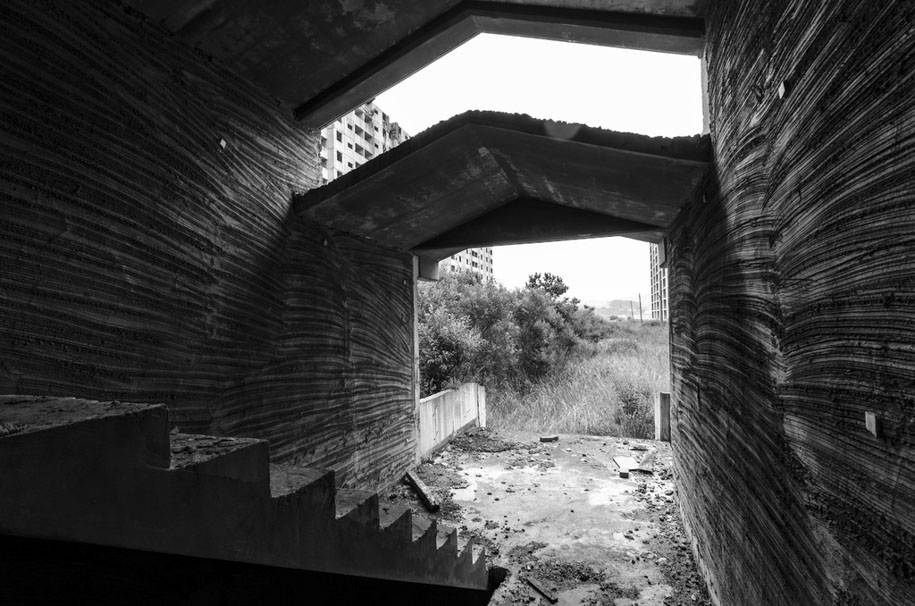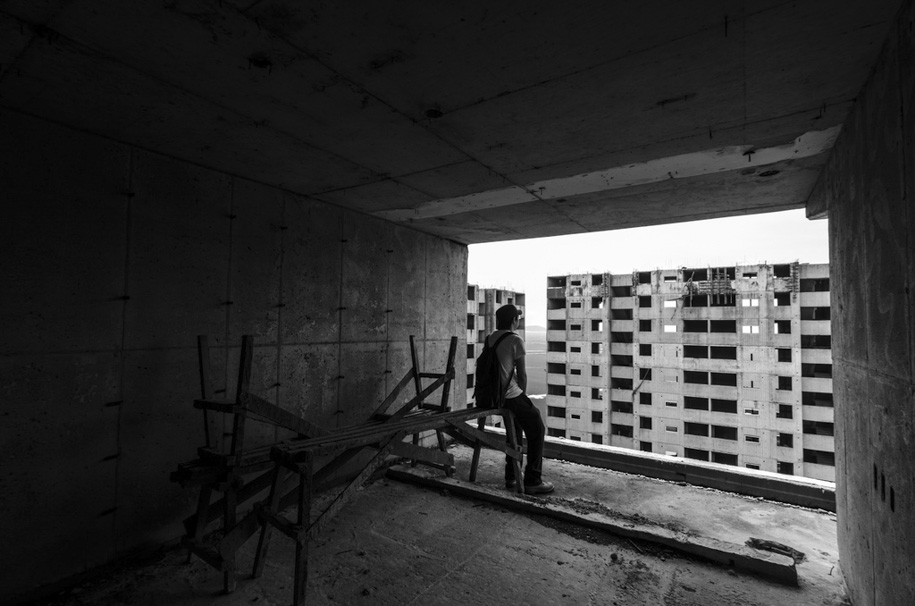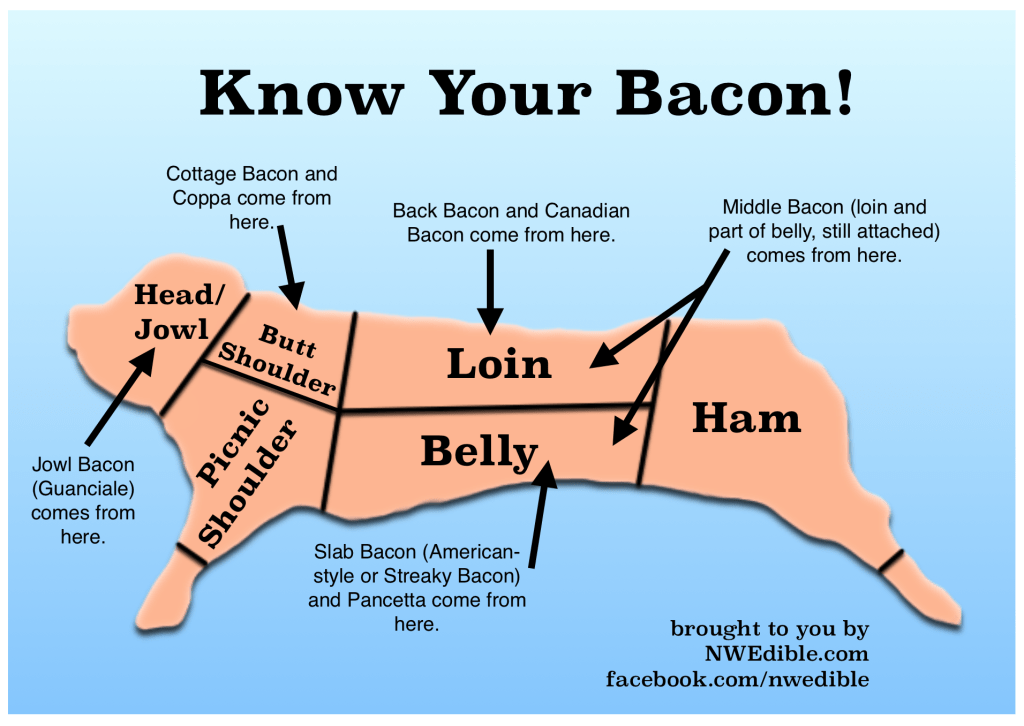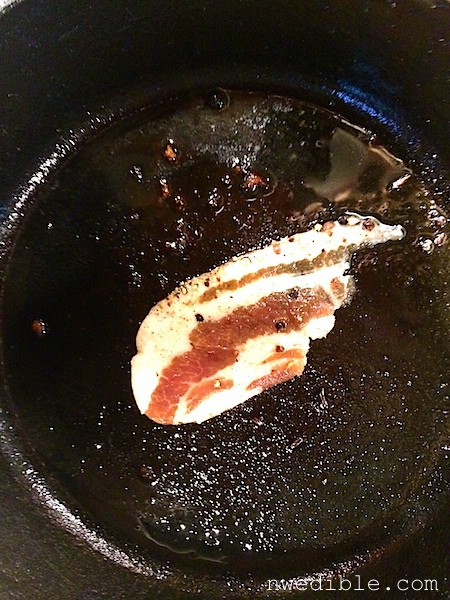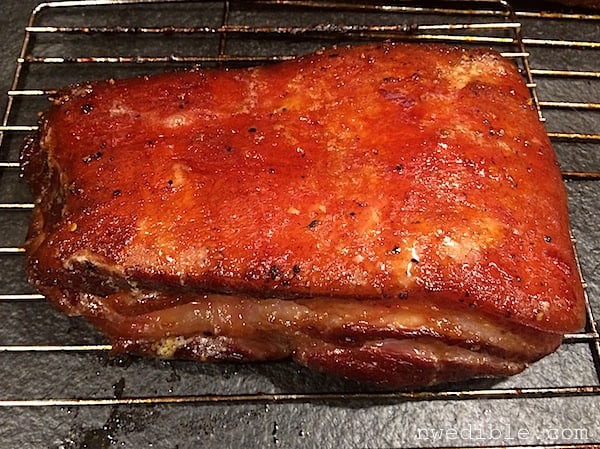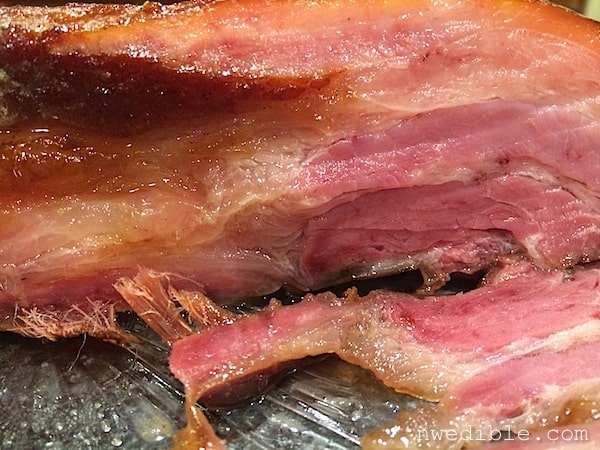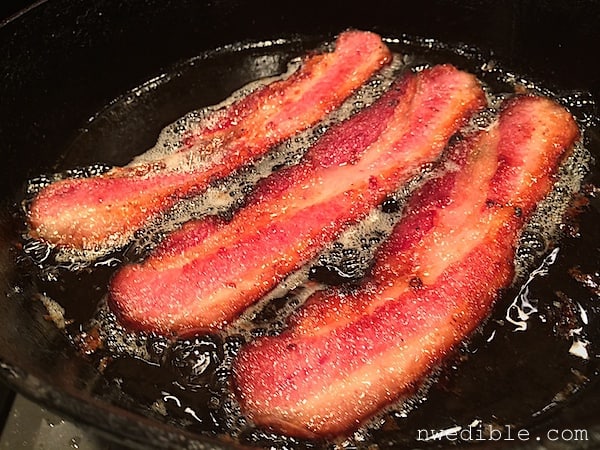Simple Simon
Shared posts
800 'captive' fish ceremonially released into river, captured by nets downstream
Last day in the office before Christmas
Simple Simonme, today! Left at 3:30, and yet still didn't beat the salesmen out!

Thanks to @helenajones07!
Paintless Landscapes: Scenic Art Made of Light & Shadow

A collection of unlikely (often discarded) objects coupled with a light source can create amazing city scenes, landscapes, portraits and more in the hands of this artist.
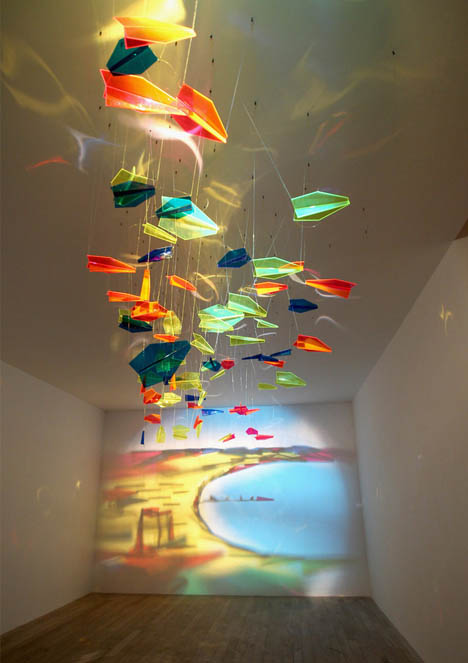
Rashad Alakbarov hails from Azerbaijan and experiments with different materials and setups to turn three-dimensional trash into rich two-dimension displays of all shapes and sizes.
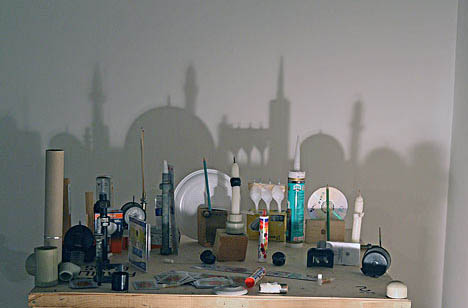
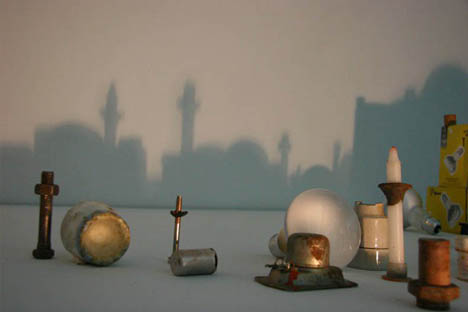
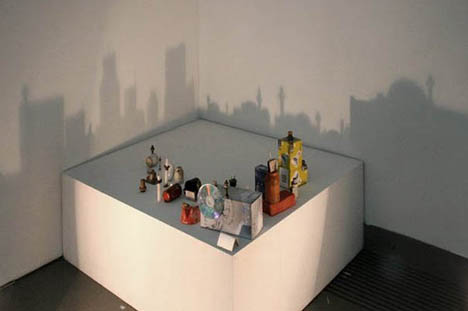
Some of these, including the top installation featured here, were on display last year at the Fly to Baku Contemporary Art Exhibition at the De Pury Gallery in London, UK.

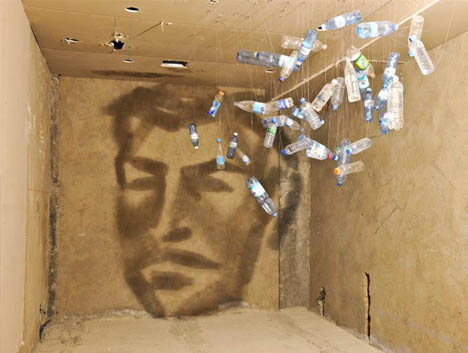
A few pieces contain custom built-to-purpose shapes, like plastic versions of paper airplanes in the top example, while others simply draw on urban junk or everyday objects.
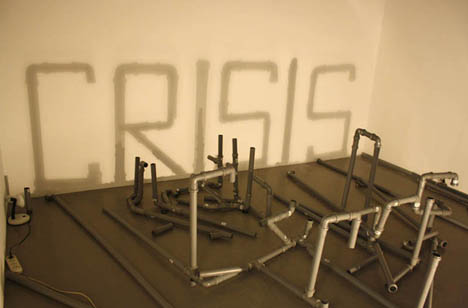
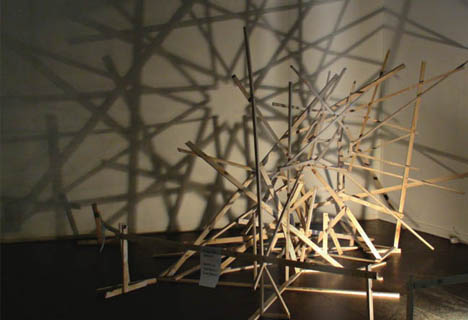
There is something playful and informal about his approach. Alakbarov takes inspiration from items at hand to start crafting skylines or other scenes that unfold partly from his imagination, but also in part from the nature of the materials in each case.
Want More? Click for Great Related Content on WebUrbanist:
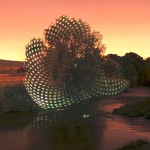
Geometric Projections: Light Art Radically Reshapes Nature
Everyone knows there are mathematical patterns to be found everywhere in nature - though few such geometries are as explicit and dazzling as these. Click Here to Read More »»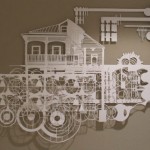
Paper Art Landscapes: Lace-Like 2D Wall Architecture
Paper artist Laura Cooperman creates delicate, intricate landscapes inspired by the architecture she has seen in her travels to places like Beijing. Click Here to Read More »»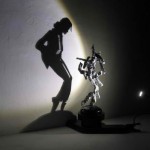
Shadow Sculptures: Illusions from Clumps of Junk
Seemingly random bits of junk produce the most unexpected shadows when a light is shined upon them from a certain angle in these sculptures by Diet Wiegman. Click Here to Read More »»



[ By WebUrbanist in Art & Installation & Sound. ]
[ WebUrbanist | Archives | Galleries | Privacy | TOS ]
Past Food: 10 Creepy Closed & Abandoned McDonald’s

I’m leavin’ it! You can bet your sesame seed buns these 10 closed and abandoned McDonald’s have swirled their last McFlurry and will bag burgers no more.
Archless In America
 (image via: Flavio Grana)
(image via: Flavio Grana)
The usual knock against modern architecture (or should we say, “ARCH-itecture”) is that it lacks character, and the stereotypical mansard-roofed “McStore” style of McDonald’s outlets is the poster child for the genre. With that said, Flickr user Flavio Grana has managed to coax a supersized amount of depth out of the anonymous abandoned McDonald’s location above. Stripped of all brand identity yet instantly recognizable, the moonlit McD’s stands alone in silent glory, a washed-out monument to conspicuous consumer culture.
Sweet & Sour Saucer
 (images via: Reddit, Comfortable Disorientation and Geograph UK))
(images via: Reddit, Comfortable Disorientation and Geograph UK))
If you thought the UFO-shaped McDonald’s in Roswell, NM was out of this world, then feast your eyes on the former McDonald’s restaurant in Alconbury, UK. First opened in 1990 as The Megatron, the distinctive saucer-shaped eatery was an interplanetary flop: in 1993 it closed but soon re-opened under the McDonald’s banner.
 (images via: Daz, Comfortable Disorientation and HuntsPost24/Geoff Soden)
(images via: Daz, Comfortable Disorientation and HuntsPost24/Geoff Soden)
After roughly 15 years serving up burgers, fries & shakes to hungry Huntingdonshire locals, the location shut down for good and (oddly for a closed McDonald’s franchise) remained shuttered for a further half-decade before finally being demolished in mid-2008. Plans are now afoot to allow six “gypsy pitches” to occupy the land where the McUFO once stood. Tramps and thieves are advised to look elsewhere.
Arch-Criminal?
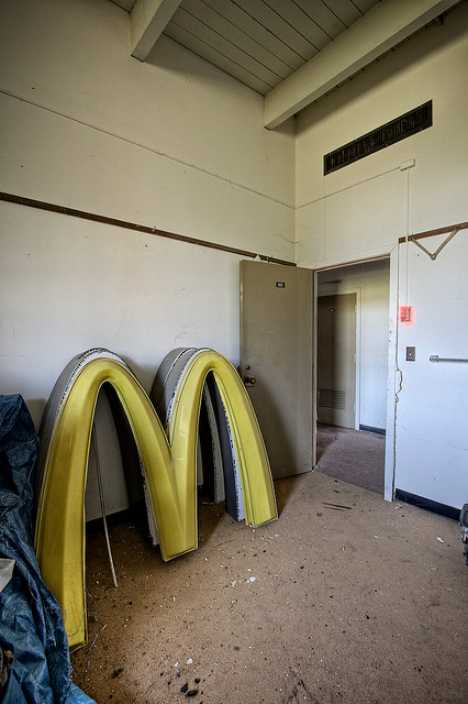 (image via: rustyjaw)
(image via: rustyjaw)
It’s not often an item (with emphasis on the “em”) this large and obtrusive escapes the watchful eyes of the McBrand Police but it seems to have happened here. Flickr user rustyjaw doesn’t explain what the Big M is doing inside an abandoned naval communications station or what plans (if any) he has for this piece of fast food M-orabilia, and that’s probably in his own best interest. Imagine refurbishing and re-electrifying the signage, then mounting it on your dining room wall… awesome to be sure, though it would definitely ruin the mood during intimate gourmet dinners.
Supersize My Storm
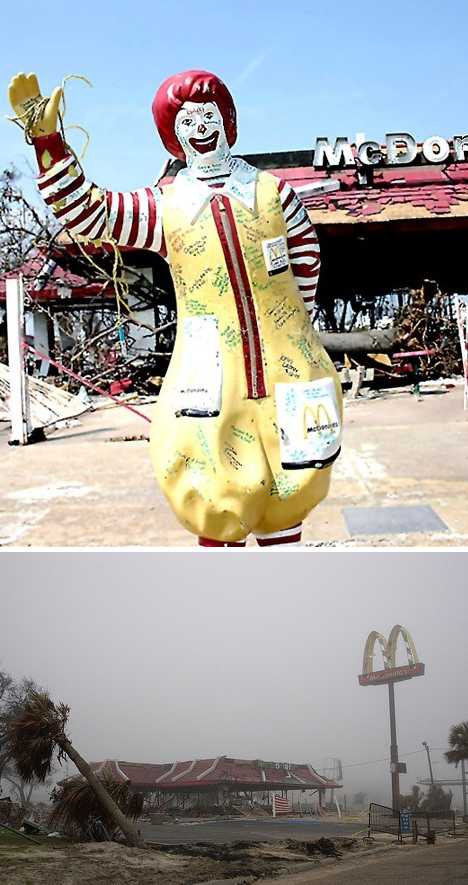 (images via: Imgur/1RgbS and Joel Carranza))
(images via: Imgur/1RgbS and Joel Carranza))
If Ronald McDonald wasn’t creepy enough already, check out his zombie clown alter-ego, still (barely) standing in Biloxi, MS, shortly after Hurricane Katrina devastated the area in September 2005. It took a while for reconstruction to get into full swing around Biloxi and the neighboring gulf coast but it was too late for both this shattered & shuttered McDonald’s and the tilted Ronald – they’ve been replaced by a Wendy’s.
Next Page - Click Below to Read More:
Past Food 10 Creepy Closed Abandoned Mcdonalds
Want More? Click for Great Related Content on WebUrbanist:
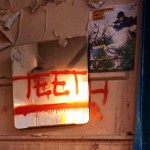
Is It Safe? Nine Creepy Abandoned Dentist Offices
These nine creepy abandoned dentist offices feature chairs even a weary marathon man wouldn't sit on. Listen to your inner drill sergeant, this will hurt a bit! Click Here to Read More »»
Uber Creepy Tour: Abandoned Six Flags New Orleans [69 Pics]
The atmosphere in an abandoned amusement park gives off a nightmarish vibe. With 69 uber-creepy urban exploration photos, we tour abandoned Six Flags New ... Click Here to Read More »»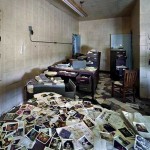
Case Closed: 12 Locked Down Abandoned Police Stations
These unlocked, unloaded and unmanned abandoned police stations suggest that when the long arm of the law has withered, the end of society must be nigh. Click Here to Read More »»



[ By Steve in Abandoned Places & Architecture. ]
[ WebUrbanist | Archives | Galleries | Privacy | TOS ]
Haunted Highlands: 7 Abandoned Wonders of Scotland
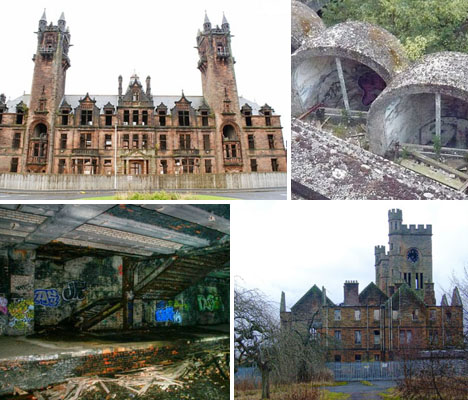
Perhaps there’s something special in the Scottish temperament that explains the presence of such an unusual number of stunning castle-like abandoned hospitals. A certain appreciation for history cloaked in moss, ivy, and – inevitably – graffiti, which is a jarring sight on the crumbling stone walls of rural Gothic mansions. Scotland is home to abandoned insane asylums, railway stations, seminaries, luxury residences and more than one isolated island ghost town.
Gartloch Insane Asylum, Glasgow
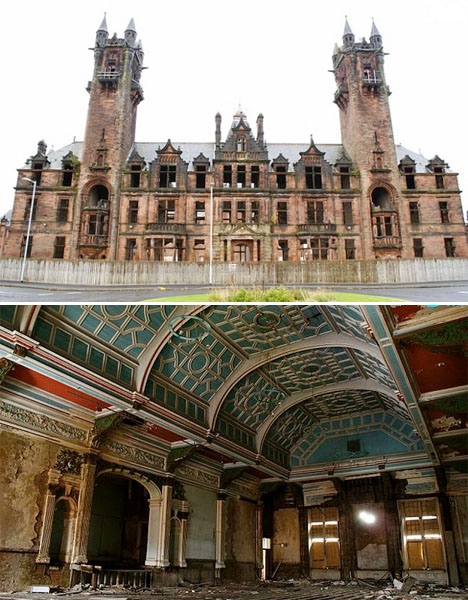
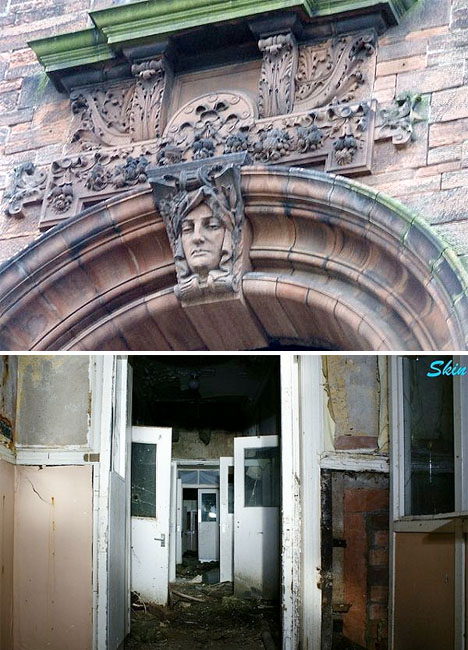
(images via: skin_ubx)
Situated on the eastern edge of Glasgow, Gartloch Hospital opened in 1896 as an asylum for poor people who were mentally ill (not that the put it that way at the time – the patients were referred to as ‘pauper lunatics.’) By 1904 it had 830 beds, and at the end of World War II, Gartloch was transformed into a medical services hospital, with psychiatric patients transferred elsewhere. The hospital closed for good in 1996 and in 2003, its incredible castle-like ruins were partially prepared for conversion to luxury apartments. Most of it was demolished, with many of the remaining architectural elements turned into private residences, but some buildings, like the dining and recreation hall, are still on Scotland’s list of buildings at risk.
Botanic Gardens Railway Station, Glasgow
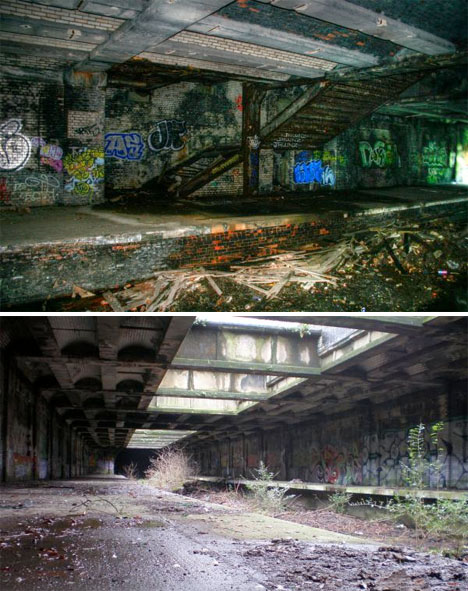

(images via: wikimedia commons, gj_thewhite)
Deep beneath Glasgow’s famed Botanic Gardens is a mostly-forgotten railway station with two underground platforms that have spent the last 70 years decaying, becoming overrun by weeds and plastered in graffiti. The station opened in 1896 to much praise as it managed to bring heavy transportation to a well-used location without disturbing the picturesque setting. The red brick Victorian station closed permanently to passengers in 1939, and was destroyed by a fire in 1970. There’s no hint of the subterranean station at ground level other than a few moss-covered ventilation shafts, offering potential urban explorers a tantalizing peek at the abandoned tunnels below. There are currently no plans to redevelop the site.
St. Peter’s Seminary, Cardross

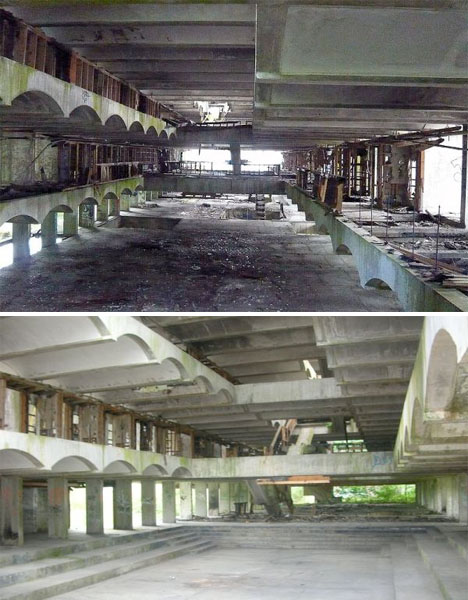
(images via: wikimedia commons)
A striking example of Brutalist architecture has become even more noteworthy as it slowly erodes into a skeletal concrete monument hidden in an overgrown forest. St. Peter’s Seminary has been described as one of Europe’s greatest modernist buildings, but since its abandonment by the Catholic church in 1980, it has decayed into “Scotland’s creepiest building.” Architecture students who want to get a look often have trouble even finding it in the 140-acre wood. The structure opened in 1966 but was almost immediately obsolete as the Catholic church had decided in 1966 that priests should be schooled in the urban churches of Europe rather than secluded rural locations, so it was never fully occupied. It briefly became a drug rehabilitation center before closing for good. A new movement to turn it into an arts college and transform the surrounding area into a public space may spell hope for its future.
Hartwood Mental Hospital
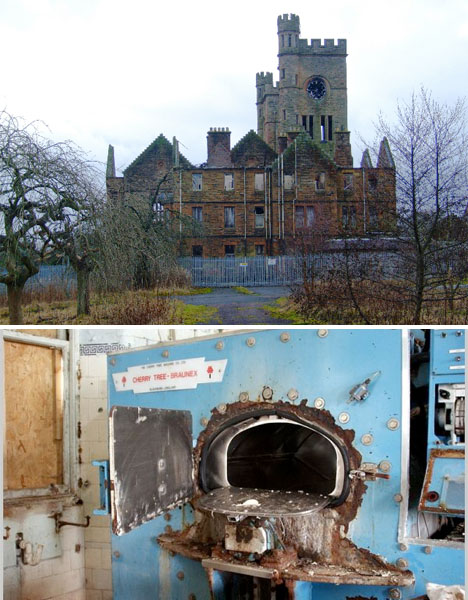
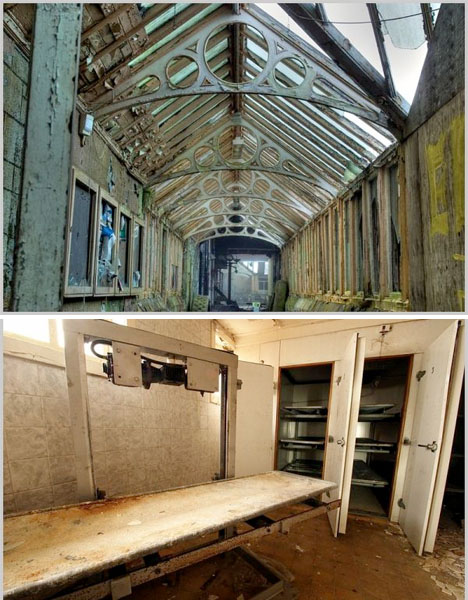

(images via: wikimedia commons)
Another properly creepy abandoned hospital was built in a location specifically chosen for how isolated it was, in the small village of Hartwood. Consisting of a number of buildings as well as its own power plant, water reservoir, farm, gardens, cemetery and railway line, the hospital opened in 1895 and quickly gained a reputation as a cutting-edge treatment facility for mental illness where patients underwent then-unheard-of therapies like electric shock treatment and lobotomies. As with many other hospitals in the area, it closed in the 1990s after a new law focusing on community-based therapy and long-term mental health care was enacted. The last two wards weren’t closed until 2010, but the facility already looks as if it’s been abandoned for decades, and several fires have destroyed the ballroom, kitchen block and admin space. It’s still owned by the health board and there’s no word of redevelopment.
Next Page - Click Below to Read More:
Haunted Highlands 7 Abandoned Wonders Of Scotland
Want More? Click for Great Related Content on WebUrbanist:

Desolate Desertions: 7 Abandoned Wonders of Antarctica
At the end of the earth, in some of the most remote places known to man, the remains of ill-advised human exploration and activity can be found in the form of ... Click Here to Read More »»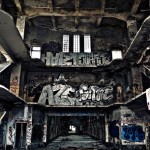
7 Abandoned Wonders of Institutional Architecture
Once grand and impressive churches, schools, courthouses and hospitals, these abandoned institutional buildings are now haunting shadows of their former selves. Click Here to Read More »»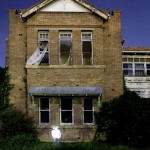
Decay Down Under: 7 Abandoned Wonders of Australia
Whether covered in colorful graffiti or slowly disappearing under a profusion of moss and vines, Australia’s most intriguing abandoned places share the ... Click Here to Read More »»



[ By Steph in 7 Wonders Series & Global. ]
[ WebUrbanist | Archives | Galleries | Privacy | TOS ]
Infinity Rooms: Mirrored Spaces Reflect Endless Starlight

The experience calls the mind the climactic moment of the classic 2001: A Space Odyssey by Arthur C. Clarke, in which our protagonist stares into the void and proclaims “it’s full of stars” in awe before being whisked off to a galaxy far away.


This pair of eye-popping installations in New York by Yayoi Kusama at the David Zwirner Gallery takes visitors into a field of suspended and spectrum-spanning LED lights, organically staggered like stars, and wall-to-wall, floor-to-ceiling mirrors.


The all-encompassing effect extends to the very door you enter through and close behind you, leaving you and as plank (Silver Surfer board, perhaps) as the only objects in a sea of apparent infinity(images by Steven Meidenbauer, and Rebecca Dale Photography via Colossal).

The artist has been making rooms along these lines for nearly half a century, but in these latest LED-filled wonderlands are the most immersive to date. The show also includes a series of illuminated sculptures, projected videos and wall-hung paintings, but culminates in this pair of these so-called Infinity Rooms that seem to step beyond the boundaries of an art gallery in exist in worlds all their own.
Want More? Click for Great Related Content on WebUrbanist:
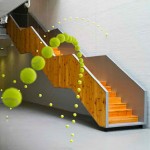
Surreal Art Spaces: 15 Stunning Gallery Transformations
These 15 art installations transformed galleries and other spaces into surreal, often interactive environments with amazing visuals and optical illusions. Click Here to Read More »»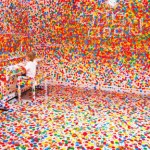
Wild Child? Chaotic Museum Art Created by Kids
A sparkling clean, blinding white living space is transformed into a chaotic canvas for thousands of children armed with stickers in Yayoi Kusama's art exhibit. Click Here to Read More »»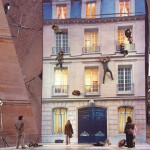
Mirrored Street Facade Art Turns Pedestrians into Acrobats
At first: vertigo. You are moving along the sidewalk, when suddenly you see the front of a structure, only on its side, extruded from the ground below you. Click Here to Read More »»



[ By WebUrbanist in Art & Installation & Sound. ]
[ WebUrbanist | Archives | Galleries | Privacy | TOS ]
When I realise it's the last full working week before Christmas
Simple Simon...and I go home on Sunday :)

Crackdown: North Korea calls for its businessmen in China to come home
Simple SimonYep, and they absolutely WON'T be executed... Notice the new "Send to" button?
Half Invisible: Deserted Desert Cabin Remixed with Mirrors

Unlike a mirage on the horizon, this quaint little abode is entirely real, even if it seems to half-disappear through alternating wood and (seemingly) see-through slats.
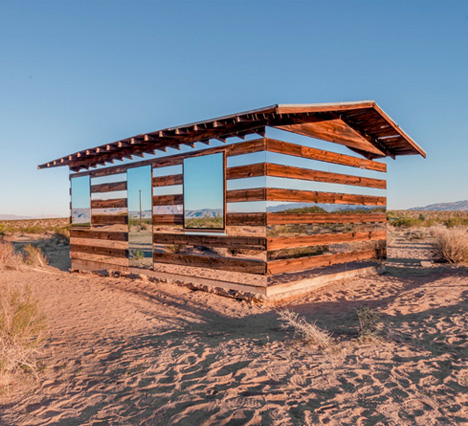
A project by Phillip K Smith III (images by Stephen King Photography and Lance Gerber), Lucid Stead modifies an existing abandoned home shape that is straightforward and familiar.

Through its materials, however, the artist makes the building interact with the landscape in mind-bending ways, reflecting its surroundings via long horizontal siding and framed rectangular (faux) windows that slowly light up at night. The effect is a strange partial vanishing of the structure.
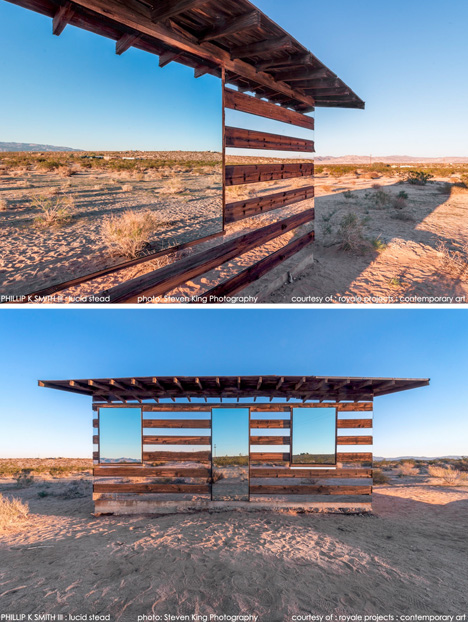
Of the work, the artist writes: “Lucid Stead is about tapping into the quiet and the pace of change of the desert. When you slow down and align yourself with the desert, the project begins to unfold before you. It reveals that it is about light and shadow, reflected light, projected light, and change.”
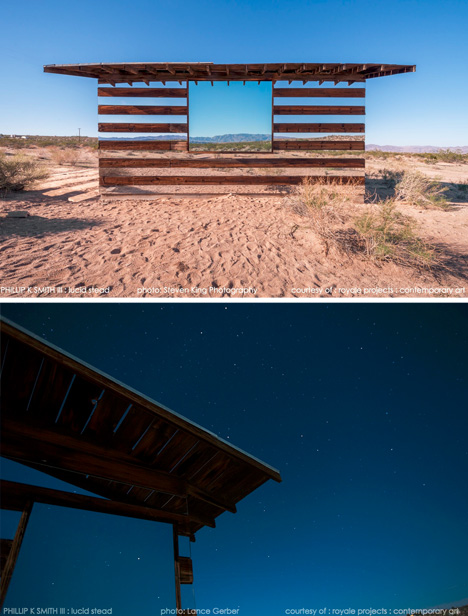
From the portfolio page: “Composed of mirror, LED lighting, custom built electronic equipment and Arduino programming amalgamated with a preexisting structure, this architectural intervention, at first, seems alien in context to the bleak landscape. In daylight the 70 year old homesteader shack, that serves as the armature of the piece, reflects and refracts the surrounding terrain like a mirage or an hallucination. As the sun tucks behind the mountains, slowly shifting, geometric color fields emerge until they hover in the desolate darkness.”
Want More? Click for Great Related Content on WebUrbanist:

Dark City: Giant Mirrors Aim to Illuminate Town in Shadows
A lovely little settlement in a lush valley of Norway sounds like a slice of paradise – except that the surrounding hills keep it out of sunlight for ... Click Here to Read More »»
Invisible Apparel: Material-Free Dresses Made of Light
Combining light art photography and high fashion, these show-stopping runway gowns are manufactured without physical material and composed purely of light. Click Here to Read More »»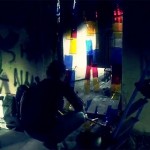
Abandonment Art: Deserted House Turned Light Installation
A lonely abandoned house was turned in to a space filled with life and light for a temporary - but utterly moving - installation. Click Here to Read More »»



[ By WebUrbanist in Art & Installation & Sound. ]
[ WebUrbanist | Archives | Galleries | Privacy | TOS ]
Climbing Wall Treadmill: Exercise Machine Rocks Your House
Simple SimonChristmas present for yourself Granty?

Far more exciting than a walking treadmill or elliptical machine, this infinite rock wall brings the challenges (and hard exercise) of scaling sheer cliffs right into your local gym or living room.

The Climbstation can be rotated between a slope of 15 degrees and negative 49 degrees, simulating everything from relatively generous slopes or dizzying upside-down climbing experiences.

The device can also rotate through different slopes, speeds and durations on demand, in response to programmatic difficulty levels or in a pre-selected sequence. As in typical bouldering rooms at climbing wall centers, a mat placed below the device will cushion any fall.


Between climbs, users can swap out 90 holds that come with each machine between 600 potential positions, dynamically changing the landscape from one session to the next to keep things interesting and challenging.


The mid-five-figure price tag will be enough to put off casual users, but could also be sufficiently low for these to start showing up not just at the homes of the rich and famous but also at regional fitness centers – a great way for recreational climbers or professionals located far from mountains to train or simply stay in shape.
Want More? Click for Great Related Content on WebUrbanist:
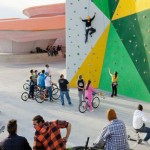
Sensational Skate Park & Urban Climbing Wall in Spain
Factoria Joven, a skate park and climbing wall in Spain, sets an example for urban youth centers worldwide with its bright and beautiful architecture. Click Here to Read More »»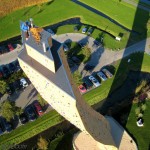
Standing Tall: 24 Jaw-Dropping Rock Climbing Walls
Climbing walls allow one to clamber up and over obstacles in a socially acceptable manner, and still chalk it up as exercise. Here are some of the coolest. Click Here to Read More »»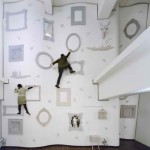
Domestic Daredevils: 12 Insanely Cool Home Climbing Walls
From small and kid-friendly to rugged and challenging, these 12 indoor climbing walls turn living rooms, bedrooms and more into scalable surfaces. Click Here to Read More »»



[ By WebUrbanist in Gaming & Computing & Technology. ]
[ WebUrbanist | Archives | Galleries | Privacy | TOS ]
China's epic supercomputer put to use tracking smog
Simple Simonsorry for the bombardment dudes...
HOT: Panda watches porn in Chengdu [NSFW if boss is panda]
Watch: Amazing tilt-shift films of The Great Wall and Forbidden City
Simple SimonWell rad
Sucking Smog: Electronic Vacuum Cleaner Clears City Skies

It sounds so preposterous and yet is sufficiently plausible that its designer is now talking to the mayor of Beijing about how to develop for urban use in this notoriously congested capital of China.
Daan Roosegaarde developed a system using buried coils of copper to create an ion electrostatic field that attracts smog particles, effectively magnetizing them and pulling them down. The result is sizable void of clean air above.

While it cannot yet work on a city-wide basis, the idea is to begin by clearing hundreds of feet of air in key public spaces like parks, squares and other paths trafficked by pedestrians.

They have already prototyped a device that can suck a square meter of polluted air from a larger interior space, effectively punching a hole in a simulated cloud of smog and collecting the resulting particles safely below.

The designer puts the problem and project in context: “We have created machines to enhance ourselves. We invented the wheel and cars to liberate ourselves and travel. But now these machines are striking back, making air polluted in high-density cities like Beijing.”

Their “young design firm based in the Netherlands and Shanghai, [which] has been working on intricate designs like a sustainable dance floor which generates electricity when you dance, and smart highways which produce their own light. Now [Daan Roosegaarde] and his team of engineers are creating a technology to clean the air of Asian cities.”
Want More? Click for Great Related Content on WebUrbanist:

Perfect Pitch: Impossibly Starry City Skies in Blackest Night
There is simply no way to see the starry skies above the typical urban metropolis - but one photographer has found a way to simulate the stunning potential ... Click Here to Read More »»
Self-Sufficient City: Zero-Waste, Carbon-Neutral & Car-Free
It sounds like a conceptual design or science-fiction fantasy, but it is already under construction. Rising in the desert outside of Abu Dhabi, Masdar City ... Click Here to Read More »»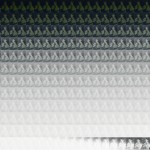
Clear Skies Ahead: Quest for a Complete Global Aerial Atlas
If you have ever zoomed out in Google Maps (or Mapquest, Yahoo or Bing), you may have been surprised find your field of view relatively unclouded by inclement ... Click Here to Read More »»



[ By WebUrbanist in Conceptual & Futuristic & Technology. ]
[ WebUrbanist | Archives | Galleries | Privacy | TOS ]
Salt Mines Converted to Stunning Subterranean Museum
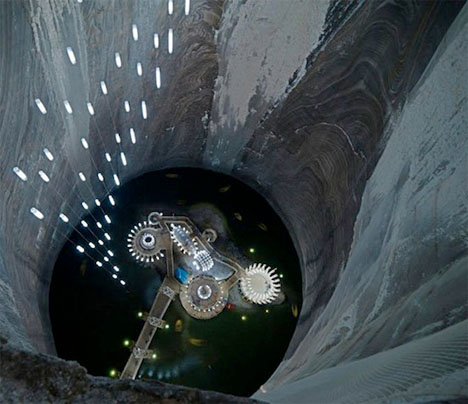
Between the eerie glowing lights, the otherworldly cavernous spaces and the long strange trip it takes to get there, this subterranean museum feels like it could be located on an alien planet. The Salina Turda Salt Mines of Romania have been converted to the world’s largest salt mining museum, but this is no dry historical tour – there’s weird wooden architecture, a playground and even a ferris wheel.
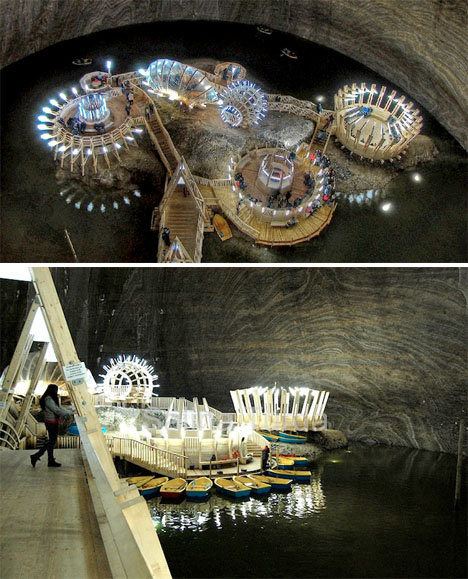
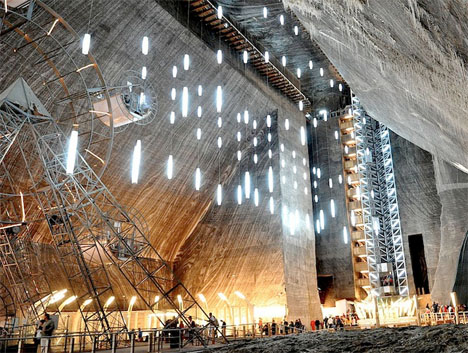
All of the LED lights sticking out of those unusual architectural shapes at the center of the museum make it quite a sight from far above, when looking down into the mine plunging 120 meters (393 feet) into the earth. Visitors take elevators to each of the three museum chambers at various depths to see the restored equipment.
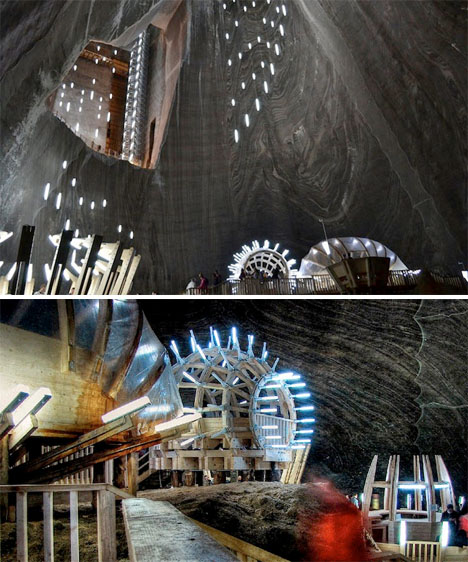
The sports arena, amphitheater, mini golf course and bowling lanes are reason enough to take a trip to the mine, but the caverns themselves are the main attraction. Uplighting shows off the amazing natural patterns on the excavated walls. There’s even a small subterranean lake with boats for rent.
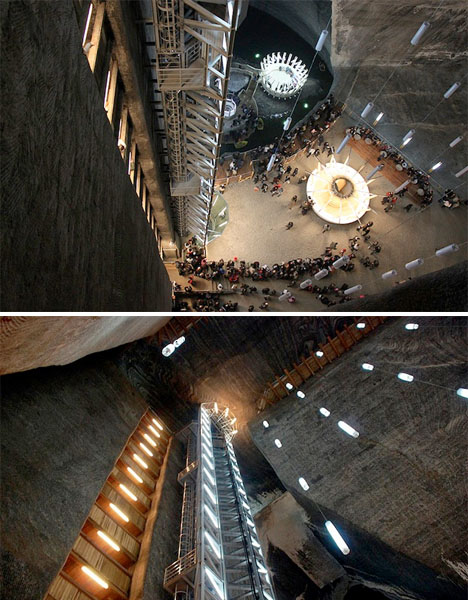
The mines were first excavated in the 17th century and provided a vast wealth of salt for the Romans. The interior is totally free of allergens and almost entirely devoid of bacteria, and maintains a temperature of about 52 degrees with 80% humidity.
Want More? Click for Great Related Content on WebUrbanist:
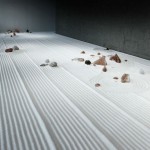
Salt Sculptures: 12 Stunning Artworks by Motoi Yamamoto
Japanese artist Motoi Yamamoto uses salt's symoblic role in Japanese culture to create amazingly complex and emotional salt sculptures and drawings. Click Here to Read More »»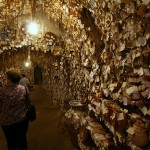
Hair Today: Turkey’s Bizarre Subterranean Hair Museum
Cappadocia's cave homes have made it famous, but there is another, less well-known attraction there: a weird museum with 16,000 samples of human hair. Click Here to Read More »»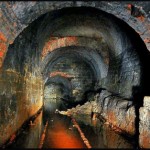
Deserted Industry: 7 Abandoned Factories, Mills and Mines
Our factories and other industrial buildings tend to outlive their primary use. What happens then? These 7 factories, mills and mines were left to crumble. Click Here to Read More »»



[ By Steph in Global & Travel & Places. ]
[ WebUrbanist | Archives | Galleries | Privacy | TOS ]
A Musical Revolution: The China Wave
Simple SimonLooked through to see if there were any bands I'd heard of...never even came across them during my time there. Also, D-22 the club closed in January 2012. And it was in the University district, way out of my usual going out zone.

As a radio broadcaster of six years standing, Ola’s Kool Kitchen on Radio 23, Rock XS Radio and Magic Monster was created as a reaction to combat the myopic mediocrity present in mainstream media. It features an eclectic mix of genres while Ola travels the world both playing and recording lesser known new talent as well as established musicians. Put simply, good music has no boundaries.
---A long time after Mao led his followers on the 'Long March' which would eventually change the face of China; there is an unlikely bloodless revolution going on now in The People’s Republic, a musical one! Most people will be vaguely aware of it because of Car Sick Cars, the main band to break through to Western audiences. There is, however, an amazing scene currently brewing there, and with only two indie record companies in the country, Maybe Mars and Modern Sky Records have an exciting roster of musicians reminiscent of Creation Records in its heyday.
I first came across the China Wave when I met Nevin Domer from Maybe Mars Records three years ago in Kuala Lumpur, Malaysia. Earlier this year, Ricky Maymi from The Brian Jonestown Massacre was a guest on my radio show featuring indie music from Beijing. After that show in an interview with Ricky and Nevin for Drowned In Sound, we discussed the fascinating background surrounding the youth movement and looked at the current political and traditional influences on modern Chinese pop music. Further deliberation revealed the notion that the Western indie scene could be bogged down by the baggage of its own history and that China’s unique exposure to Western pop culture is creating a vibrant and innovative sonic fusion. With this injection of another vision/version from China comes a rebirth, worthy of appreciation and consideration by European audiences. Here are the fruits of our interview, including 5 important bands from Beijing you need to hear.
Ola’s Kool Kitchen: Why China now? What is happening there that has spawned this scene?
Nevin Domer: I think there are a lot of factors. China is going through this period of amazing economic growth. It’s the right time for this, Youth culture is sprouting up in China that didn’t exist a couple years ago.
Are there social, cultural or political reasons for that?
ND: I’ve been in and out of China since '99. I first moved to Beijing and got involved in the scene in 2005. At that time, it was still kind of the older scene. This is where Car Sick Cars and those bands were getting their start. A lot of those kids and the ones that came before, like P.K.14 were still coming from positions of privilege. Since that time, especially the Olympics, the underground youth culture has exploded. A new generation of kids with a disposable income have opened this up.
So would you say there is a parallel to the 50’s and 60’s in America where teenagers had a disposable income and became an economic force?
ND: Yeah, that’s what I’d say. When I say privileged that’s kind of a relative term, the kids at the beginning were privileged but they were also punk kids living in conditions that in the west we couldn’t imagine living in. They still came from a small group who actually had the freedom to get involved in this sort of stuff.
Their notion of class is relative and very different to the West?
ND: The majority of Chinese people are just trying to get by working 12 hour days. A lot of Chinese actually live at their work place and are involved full time in their job. When you get kids who actually have the freedom to do something else they are going to universities. That’s already pretty privileged compared to the majority of people living here. It’s not the sort of privilege we might imagine in the West. The number of kids that do have access and exposure to rock music through the internet to listen to it or whether it’s through the ability to buy guitars or through the freedom to pursue it is growing. Before that it was a very small number of people.
Ricky Maymi: Also my understanding of it is that to be in a band in China was the equivalent of being in a Dungeons and Dragons group. (laughs!) It’s not something you tell someone you do to win any points with them, It’s more like something you do with a certain group of people when no one else is around. You keep it to yourself, cause it’s kind of frowned upon. It’s not like a cool thing.
ND: That’s very true actually... I think that’s a really good point, especially when bands like Car Sick Cars were starting out. The kids at university didn’t go to bars, they didn’t go out. They just spent all their time studying. The whole point of university here is to study and graduate with the highest scores and the most connections you can so you can get a nice, well paying job. Being in a band wasn’t a cool thing to do. There was no affirmation from your peers for doing it. That’s starting to change now to. It also wasn’t financially rewarding. There weren’t any brands or sponsorship pre-2008, so kids were doing music really against the grain.
Ricky mentioned this before and it’s true, what’s coming from China is from nothing. Our reasons for originally starting to do rock n roll, have been watered down by so much baggage, expectations and so many other cultural icons, while China is approaching this from a void.
ND: Yeah I think it’s a good point. In the West you have that cultural baggage where you look at something and you immediately know the whole context behind it and how it fits in. A good example is P.K.14; when you ask them about their influences, they name everything from Glen Branca, Woody Guthrie and Fugazi and they pretty much discovered this music all at the same time. There is no real context for it. They just threw it all together to make their sound and image.
Yeah they were bombarded with it all at once. Bam here you go, pick what you like, interpret how you wish. Another example of this I found in the Red Rock (a book describing the birth of pop music in China), was this little guy in China in the late 80’s, who heard Norwegian Wood by The Beatles, wanted to find out more and looked them up in the dictionary only to be disappointed. He had to search to find out what or who they were. That’s just unthinkable in the West. We didn’t have to search for The Beatles. We have documentaries and zillions of pop books on the subject.
RM: You don’t know how little that guy was? (laughs!)
Let’s talk about the venue D22 in Beijing and its importance in creating the scene. The venue is gone now but there’s a legend about it and how it was at the heart of things.
ND: It was a really amazing place and it was the right time for it. When D22 started, the scene was beginning to grow. D22 created a home for it, a place where the bands could all play. It did the trick like CBGB’s and a couple of places have done, where any musician that plays there also drinks for free. That meant it was the place everybody hung out. Partly that and the fact there was no other club like it at the time. So you’d have the punk musicians hanging out on Sundays for jazz shows or for really weird experimental stuff. That brought the scene together and people started moving in weird directions with weird influences. It was an exciting time for music. It’s changing a little now, which is good and bad. It was great with D22 but to be honest, right now the scene is much bigger with more clubs, and in some ways it is much healthier than it was before.
The first band I’d like to talk about is P.K.14. There is a core of people that keep reappearing in the bands of interest. It’s an incredibly incestuous scene.
ND: If you look at the scene as it is now with Car Sick Cars, Snapline and those sorts of bands, P.K. 14 can be seen as the Godfather of that. They actually bridge the gap between some of this weird interesting music that was coming out in the mid 90’s to Car Sick Cars and the bands that started in 2005. P.K. 14 were playing in 99. They were probably the first band to really define the idea of playing post-punk inside China. When they started was also when punk hit. You had bands like The Board Contingent, which was like Brain Failure, 69, Anarchy Boys and Reflector. Those were the early punk bands here. At the same time, P.K. 14 were doing post-punk. The very beginning was Cui Jian with his ballad rock; then came arena metal like Tang Dynasty, which got really huge. After this came this really weird, if you’re trying to understand them in the Western context, proto-punk that bridges this ballad and arena metal with more experimental interesting stuff.
RM: I think P.K.14 are great. As Nevin said, they were the first band to merge these sounds. They have proven to be really influential.
ND: Yang Haisong is the band leader. P.K.14 really works with all four people writing the music together, but he’s the front man and the singer. He’s also a producer. He produced the very first Car Sick Cars album, which is the album that ushered in the 2005 wave of post-punk. That sound became what Maybe Mars is and what Beijing is now. He’s also starting his own record label and plays in a couple of side projects including Dear Eloise which is him and his wife. They’ve been extremely involved and supportive of the young scene.
RM: It’s like Nevin said, P.K.14 sort of naturally crossed styles. That’s what I noticed about their music as well, there’ll be instrumentation and melodic passages with things that are really simple, yet bizarre at the same time.
How are they bizarre?
RM: Just a different application of aesthetics with interesting song writing, but not in a try hard way.
ND: And super influential! I mean P.K.14, whether they’re doing Car Sick Cars shoe gaze type music or more experimental stuff is the band all the kids pretty much point to as an influence.
Everybody cites Car Sick Cars. If anybody is going to know a band outside of China it’s this one, yet P.K.14 is the precursor?
ND: You have to have the band that breaks out. I think Car Sick Cars, originally supporting Sonic Youth and then playing All Tomorrows Parties and Primavera are the first band that caught the attention of people abroad. When Car Sick Car started there was no possibility of making any money at this. Car Sick Cars is of the first generation of bands that are actually starting to support themselves through their music. P.K.14 being older with all of the members having full time jobs makes it a little harder for them to consistently tour.
This is an important factor isn’t it, that they can actually see they can make a living doing this? Within Chinese society, and this is also true of all the places I’ve travelled in South East Asia like Thailand, Malaysia, Indonesia etc. there is no social security or welfare state. Your family is your complete and utter social network. You have much stronger familial obligations to fulfil than in the West. Whatever the pressures of being a musician in the West, there are triple those pressures or obstacles to overcome in China. There is no infrastructure, expectation or belief that you can make money as an artist. In the West you’re more likely to get more support from your family to pursue it.
ND: That’s definitely true for China. It’s not just about having support from the family. They are actively against them doing it because there is no future and no money in it. They are coming from this early middle class. Their parents have worked their way up and now they want the lives of their children to be better than the lives that they had. They feel like their children are shooting themselves in the foot by becoming musicians.
Not a lot these bands get to leave China. When a band does go abroad are their noticeable ramifications? Does it help their image?
ND: Yes. Especially if they go to the US, that’s a huge boon. If a band from China goes abroad all of the sudden they are perceived as a different band on a higher level than before they left. On a practical note it also helps them get more money for festivals and shows here. Also the audience pay a lot of attention to them because they’ve played abroad.
RM: Australia is like that. You’re sort of not valid until you’ve gone and done it overseas. They need confirmation that someone else cares about you elsewhere. They have a cultural insecurity about their identity. It holds more weight if it’s been validated elsewhere.
That’s interesting. Do you think the Chinese are insecure like that too?
ND: That is exactly true. Insecure is one way to put it; there might be other ways to pin that down. A lot of the music media in China didn’t pay attention to local bands. The media pre-2005 wouldn’t talk about local Chinese bands, it would all be foreign bands. Then as Chinese bands started going abroad getting press and playing festivals, all of the sudden the Chinese media was like “woah”, if the people in the US are paying attention to this band then we should too.
Back to P.K.14, what’s the new album like?
ND: The new stuff sounds amazing. It blows a lot of the other stuff away. P.K.14 are just surprising me. I love all their past work but their new stuff is actually a world above of it.
RM: What would you say the difference is sonically?
ND: It’s really hard for me to describe. The only word I can think of- and it kind of sounds a bit BS, it’s just mature....
RM: Yeah I can hear it going that way. I’ve been listening quite a bit lately to the three albums I have and the song writing has a got a little more depth perhaps?
ND: Yeah! If you take City Weather Sailing, Xièxiè, and White Paper; the early stuff was more rock and City Weather Sailing was a little orchestrated. Mix all those elements together, you have a more balanced sound that is also more mature.
P.K.14 performing '1984 Pt II' live off their new LP '1984'
Let’s talk about Mr Graceless.
ND: We came across them back at D22. We had Wednesday nights that were for university bands, this would of been about 2010. At the time myself and Michael Pettis (Maybe Mars founder) were going to every show at D22 and once in awhile we’d see a band that really stuck out. Mr Graceless was one of those. When they played they just blew us away and they added something to the scene that wasn’t really present before. They resonated with university students in China coming from a more pop audience. At the same time they reached in and drew from that experimental stuff from like Car Sick Cars and Snapline that are influenced by Sonic Youth and those sorts of bands that add noisy dissonance into the pop music they make.
RM: They write really great pop songs. The guitar parts, the vocal melodies just all staggeringly well written and beautifully executed. It’s like something you think you heard before, but you haven’t. They just managed to find this way to write these classic pop songs. It’s just another example of how it still can be done.
The singer from the Lilys has been in touch to collaborate with Mr Graceless. How did that happen?
RM: Kurt Heasley lives on ashram in Virginia. He is pretty inaccessible but he just happened to be in San Francisco when I got back there one time. I had a handful of these Maybe Mars CDs. I was just thinking about Kurt because I was listening to that Mr Graceless album and it really reminded me of the Lilys in an uncanny sort of way. You should have seen the look on his face as I played him the album. He was like, oh my god what is this band, who is this...this is great. We kind of had this moment. Ultimately the idea is to get everyone everywhere. We want to get Mr Graceless to America and it would be great to get someone like Kurt playing to audiences in China.
ND: Mr Graceless will be going to the US, if not this year then next. It would be great to hook them up to the Lilys there. I’m also trying to do the groundwork here to bring more musicians into China. That’s growing and becoming more and more possible. That’s the end goal.
Mr Graceless performing 'License To Capture' live from their album 'The Tree Ever Green'
Let’s talk about The Gar and their importance!
NK: The Gar came about from a precursor band, Nezha that were at the same time as this new 2005 Beijing sound, of Car Sick Cars, Snapline, White and Queen Sea Big Shark. They are a really amazing band. It’s hard for me to define, it’s as if you took Sonic Youth and Weezer and mixed them together.
RM: They don’t have an obvious sort of edginess to them. It’s pretty straight forward with a very melodic sound. I think anyone would like it. It should be said, none of their songs are sung in English. It’s all in Mandarin. Even though I don’t understand a single word he’s saying, it’s some of the most beautiful, emotive music I’ve ever heard. You really respond to it on a whole other level because you’re not rationalizing the meaning of his lyrics. It’s really engaging when you factor that in. I find it a very involving experience listening to the music, especially the newer stuff. It’s not edgy on the surface, but it is sort of edgy in its freedom of composition and the song writing arrangements. It’s very wild in places but never messy. Nothing happens by chance, it’s very meticulously put together. Lots of really beautiful guitar melodies that really remind me of Martin Phillipps from The Chills or David Kilgour from The Clean; a very distinctly kind of Southern Hemisphere melodic guitar-pop sound. I also know that a lot of the stuff that it reminds me of is music they’re unfamiliar with, so that makes it interesting for me on a lot of levels.
ND: One side note here about lyrics. I often find it really interesting when bands do sing in Chinese. P.K. 14, The Gar-Car Sick Cars is about half and half- do make really good use of Chinese. For most of the bands, English is not their native language, so the lyrics in English tend not to be as well written as when they do it in their native language.
RM: Which makes them brilliant to me and gives them a level of poetry we don’t get from Western writers.
ND: Some bands like Mr. Graceless pull it off amazingly, that’s also a point that makes The Gar special in that regard. When you ask the bands, why do you sing in English, they say they have a hard time writing the music in Chinese. The way pop music sounds is really based on the English language. So these bands, when they sing in Chinese, they have to learn how to make their language fit the music. They didn’t have a lot of models to look at, so they had to create these singing styles themselves.
'Cat' by The Gar off their album 'The Gar'
We talked a lot about bands from Maybe Mars what about a band that’s not on the label?
ND: An older band of the 2005 generation that is similar to a Maybe Mars band, but one that didn’t end up on our label is Hedgehog on Modern Sky Records, which is also one of the biggest bands inside China.
RM: Again, they don’t always sing in English. I have to stop and check what they are singing half the time. They’re quite clever with the Chinese sense of melodicism as well as the song writing; not a million miles away from The Gar in their aesthetic, it has a real universal appeal. They have an incredible drummer Atom, she’s like 5’2. She’s this dinky little person who looks about 15-16 years old and she is this lady that plays drums like it’s nobody’s business who is really an inspiration to watch. She’s very hard hitting, a consistently powerful drummer. In fact she could be in anyone’s band and make it better just by being in it. She is that good!
ND: She actually steals the show a lot of times! The band is incredible but she’s the one people end up staring at in the front row! Not only is she hitting the drums so hard, she’s also singing quite a bit too.
RM: Yeah she really is in command behind the kit back there and it’s unusual and striking.
Hedgehog playing 'Surf With Shark' live off their album 'Sun Fun Gun'
Let’s move onto Snapline.
ND: When Maybe Mars started, it had three releases, Car Sick Cars, Snapline and Joyside. Joyside was one of the older ones, starting in 2001. They were more 77 punk orientated. Snapline and Car Sick Cars were the two bands that ended up defining what became D22 and the early Beijing sound. Snapline have been the more underrated of the two. While Car Sick Cars have got a lot of attention, Snapline have been a little more low-key. The stuff they’ve done has snuck its way into the sound of everybody from Hedgehog to Queen Sea Big Shark and to the new generation of bands.
RM: Their earlier stuff is like Chicago Wax Tracks meets cool kind of English post-punk guitar edgy minimalism. There is some connection there, because they did some work with Martin Atkins, who is from a band called Pigface and the drummer from Pil, which is directly linked to that very thing. So imagine that mixed with Colin Newman’s side of Wire, the way he wrote from Chairs Missing till now. It’s a nice combination of sounds, never that dense with a lot of space; it is pretty minimal.
ND: Yeah the way they use their instruments and the way Li Qing plays guitar, just astounds me. She definitely doesn’t play in any traditional sense, the way she wrangles noises out of it. A lot of that sort of experimentation with sound - also adding synths and then eventually oscillators - owes its influence in the Chinese scene to Snapline.
RM: Yes, influencing the bands in the scene to a more electronic sound. They’re a bit dark and mysterious without being too serious.
ND: A little bit of their history, like Ricky mentioned, Martin Atkins came to China in 2007. We set up some shows for him at D22. He checked out a lot of bands here, one of the bands he was really into was Snapline. Eventually he worked out a deal with them for Invisible Records and recorded and produced their first two albums. Both of which I thought were very brilliant and well produced. The band did take a little bit of exception to the second album and they actually rerecorded it and produced it themselves. Now their second album has two versions.
Why did they take exception to Martin Atkins production on the second album?
ND: Maybe taking exception is a little too strong a way to put it. Martin produced a very layered and a very dense version of the second album. That’s what they did in the studio, but between the time that they recorded it and the time that it was ready to come out, they changed their minds and approach to it. They wanted to simplify everything and take away this whole layered aspect. So they recorded another version and both versions are amazing, but it’s two completely different approaches to the same compositions. We released both of them together as a double CD. The album has two names Martin’s version is Future Eyes and their version is called Phenomena.
Is there any relation between the compositions?
RM: I’m wondering how they got from one idea to the other on some of them. They are a strangely intriguing group. Those are the kind of ideas people usually talk about and don’t see through. They actually saw it through with very interesting results, so good on them.
ND: The way they approached it is really interesting because they’re serious geeks. The singer is actually a programmer for Microsoft. The idea behind their side project, Soviet Pop was to create this idea of the Soviet Union, especially emphasising the time when technical engineers were shipped in the 1960’s from the Soviet Union to China to teach the Chinese these skills. They were playing with that idea and thinking about what pop music would be like in the Soviet Union. It’s a very laboratoryesque, technical and experimental music. That’s basically what they are, technical engineers that are trying to use that sort of training to make pop music.
'She Blinded Me With Science'! Right?
(Much laughter!)
RM: Exactly, a scientific approach to rock music!
Snapline performinging 'Flu' live from the album 'Phenomena'
Any closing thoughts?
RM: I’m glad this is all happening and that this music is being made. From what I can see, it’s the most valid subculture movement happening in our time. I’m glad to have stumbled upon it in a place I wouldn’t have imagined. It’s all really intriguing for me and I’m really inspired by it.
ND: Going back to how we started the conversation, I would say there is a lot of youth in China starting to find a voice and an outlet. I do think the music that is happening now is something that will continue to grow and change. The bands we were talking about are spawning a new generation that instead of drawing their influences from abroad are actually taking their cues from inside China. Now is a very exciting time to see where this stuff goes. In China, the scene is literally just starting and that’s what makes it exciting.
Is Car Sick Cars the Beatles; the beginning of creating a cultural baggage of pop culture?
ND: Maybe they are creating this baggage but the beginning of this music in China is so different from other places. It’s going to head in a direction that’s completely new and interesting and that’s what is fascinating! That’s why I’m here. I came to Beijing and got so addicted to the music scene, it’s like a cliff hanger for me. I’m always waiting to see what’s going to happen next and I just can’t leave at this point because I don’t want to miss anything.
If you’d like to hear more from the Beijing scene, here's Ricky Maymi and myself playing the music and discussing it further on my radio show.
Ola's Kool Kitchen can be found on Facebook and Soundcloud.
Phone Keypad
Phone Keypad
I use one of those old phones where you type with numbers—for example, to type "Y", you press 9 three times. Some words have consecutive letters on the same number. When they do, you have to pause between letters, making those words annoying to type. What English word has the most consecutive letters on the same key?
Stewart Bishop
We can answer that question with the following headache-inducing shell command, which finds all words in a given list which use the same key a bunch of times in a row:
cat wordlist.txt | perl -pe 's/^(.*)\$/\L\$& \U\$&/g' | tr 'ABCDEFGHIJKLMNOPQRSTUVWXYZ' '2223334445556667777888999' | grep -P "(.)\1\1\1\1\1"
The winner, according to this script, is nonmonogamous, which requires you to type seven consecutive letters (nonmono) with the "6" key.[1]It's actually tied with nonmonotonic. These no doubt both lose to more obscure words which weren't in the wordlists I used.
Phone Keyboard Sentences
It's rare for a word to have all its letters on the same key; the longest common ones are only a few letters.[2]Like "tutu". Nevertheless, using only these words, we can write a high def MMO on TV, a phrase whose words use only one number key each.

There are plenty of other phrases like this, although some of them are a bit of a stretch:

Typing issues like this aren't limited to old phone keyboards. For any text input system, you can find phrases which are weird to type.
QWERTY Keyboards
It's a well-known piece of trivia among word geeks that "stewardesses" is the longest common word you can type on a QWERTY keyboard using only the left hand.
In fact, it's possible to write entire sentences with just the left hand. For example, try typing the words We reserved seats at a secret Starcraft fest. Weird, huh?
Let's take a look at a few more sentences—written with the help of some even messier shell commands and Python scripts[3]I constructed these sentences by searching text logs for sentence fragments that fit a particular constraint, then randomly connecting those groups together using a technique called Markov chaining. You can see the code I used here.—which follow various constraints:
Left hand only


Right hand only


Home row only



Top row only


And lastly, if anyone wants to know why you're not more active on social media, you only need the top row to explain that you're ...

Urban exploration in Korea with Nikon D7000 and Tokina 11-16mm f/2.8
Simple SimonMarie Celeste.
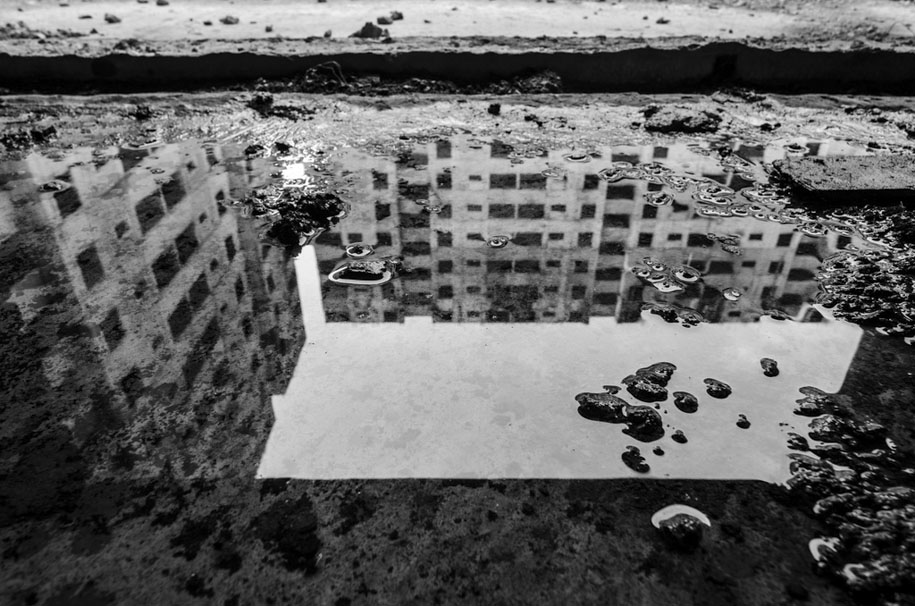

In this guest post Jackson Hung describes his documentary project on urban exploration in Korea he did two years ago with a Nikon D7000 camera and Tokina 11-16mm f/2.8 lens:
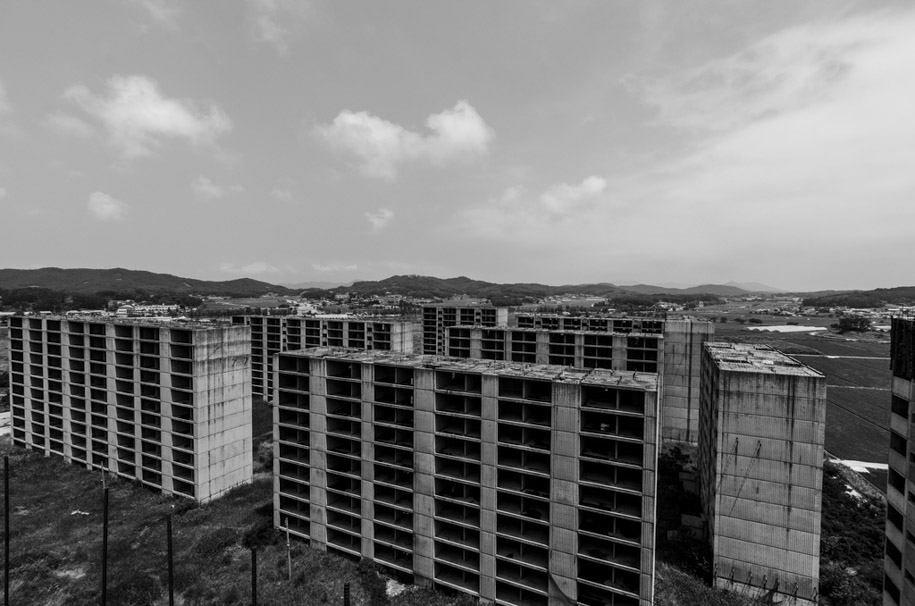
Somewhere in central Korea, stands a massive complex which consists of 14 half built “abandoned” apartments. They used to be known as the “Yuseong Sola Apartments(유성소라아파트).” The original developer for this project was “Hanguk Property Trust(한국부동산신탁(주)).” From the information that is posted on what used to be the construction gate, work commenced some time in 2007.

The average height of the apartment buildings ranges from 12 to 14 stories, depending on the building. It is visible when one is taking an arterial road which is separated by large rice fields and to what seems to be an old unused airstrip. Being curious about the apartments, my friend and I set off on our own little urban exploration.
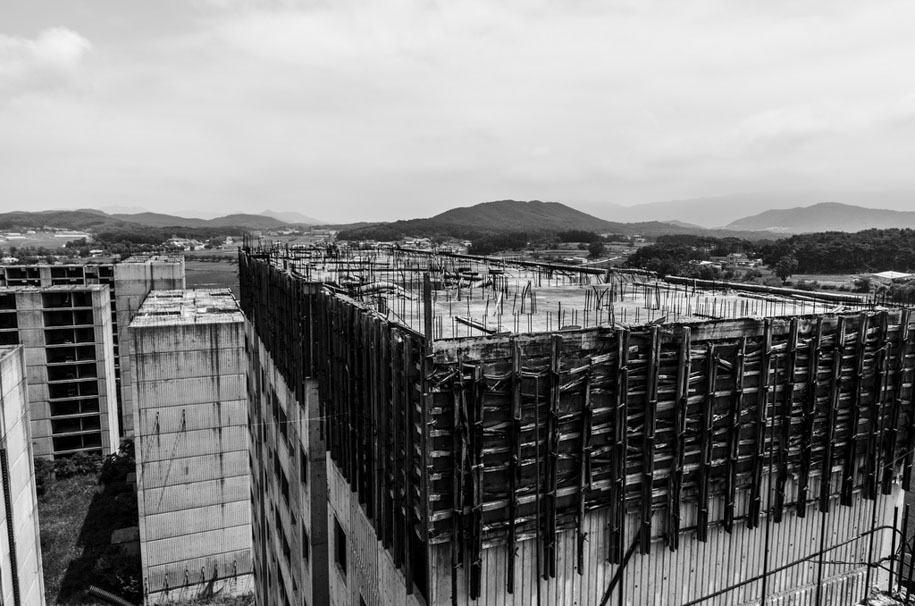
We ventured into two buildings that were accessible from a small road. The amount of space that the complex occupies is immense, with the longer buildings being able to take up an entire city block.
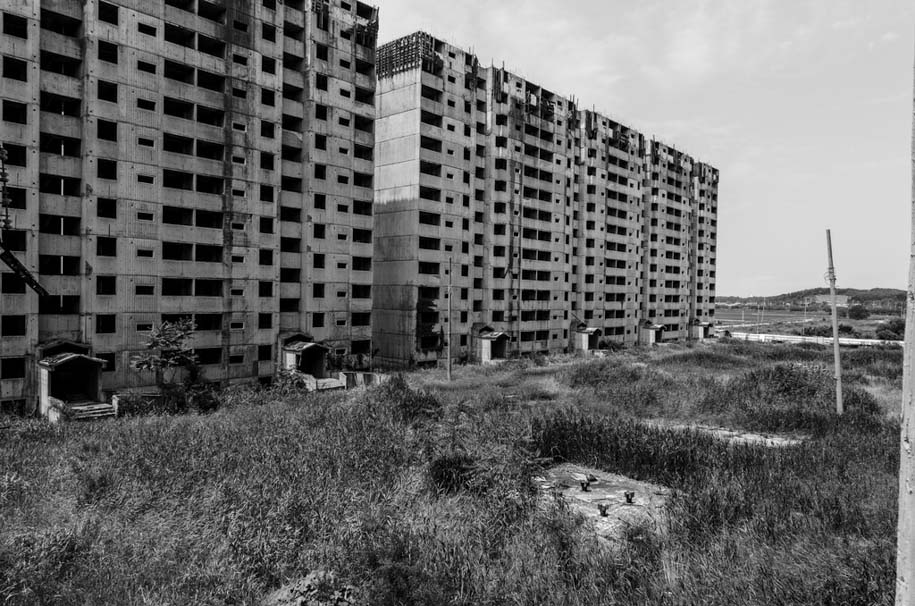
From what we observed, with the amount of construction equipment, bricks and mortar that were placed in each floor, it seems as though the construction workers simply just got up and left. Even the molds that are used to construct each floor hang precariously on the last floor that they constructed.
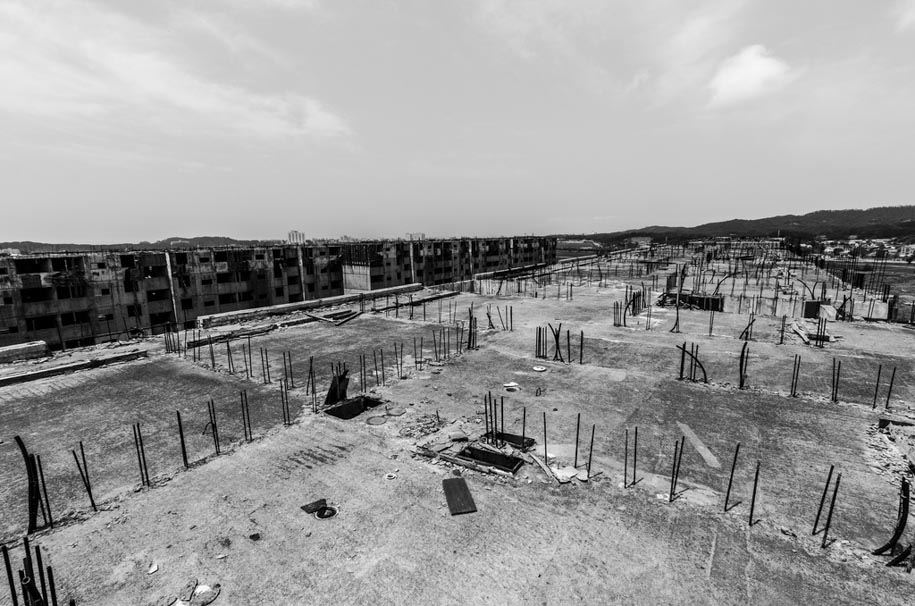
We managed to climb up to the twelfth floor, with the thirteenth and the “rooftop” being blocked off with ruble and construction equipment.

There was an eerie emptiness while we were exploring though the floors of the apartments. In this massive complex were only two people, wandering around to see what they could find. What could have been a thriving community, filled with the sound of laughter and joy, with children playing in the courtyards, and families taking their evening stroll down to the beach to enjoy the sunset; this wonderful “could have been” scenery has all but reduced to bare, cold, and emotionless walls containing nothing but empty space and overgrown vegetation.

During the exploration, I was deeply obsessed with one question; why did they stop construction? Once I processed the photos, I did a brief search on the internet but interestingly, no information could be found. The only thing which I could do was to ask colleagues at work if they knew anything about these apartments.
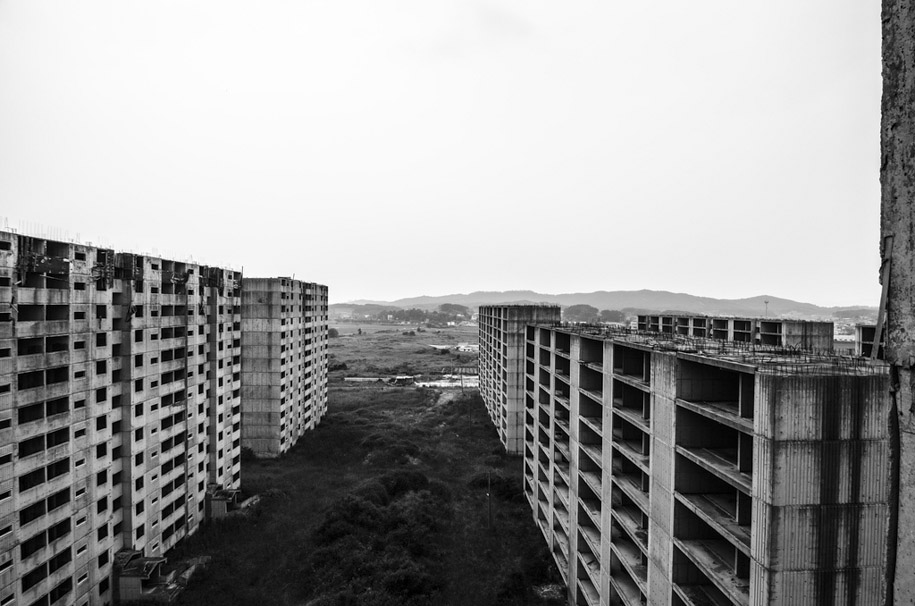
Surprisingly, only one person knew something about it. According to what she knew, the original contractor, “Yuseong Construction Industry (유성건설산업(주))” went bankrupt some time in 2008. The project was bought up by another company but for some reason, work never really continued.
Aerial photos from 2008 indicates that construction already come to halt with the lack of construction vehicles on the site. In the 2009 aerial photo, one can observe that Mother Nature has slowly taken over the empty spaces between each apartment complex.

As of today, the whole site is still considered “under construction” but with the absence of construction workers and the large scale of vegetation that has taken over then construction site, it seems as though the complex will never be finished.
If you have an interesting idea for a guest post, you can contact me here.
Posted by NikonRumors.com
This RSS feed is copyrighted and cannot be republished in any way without permission.
Follow [NR] on Facebook and Twitter.

Related posts:
Guest post: The hunt for Aurora Borealis
Simple Simonif it ever stops raining here, I might see some of this stuff, although, no tripod at the moment :(

This aurora time lapse movie and VR experience guest post is by Göran Strand (Web | Facebook | Twitter):
My name is Göran Strand and I work as a photographer in Östersund, Sweden. My main area of photography is astrophotography and landscape photography. I've been hunting auroras for several years and on March 17 I had one of the greatest aurora experiences ever.
That night I actually went out to take photos of the lovely comet PanStarrs with my small refractor telescope and my Nikon D800E camera. Here you can see a shoot of the location from that night, out on the ice on Sweden 5th largest lake Storsjön. In the foreground you can see my gear for doing astrophotography, a Celestron CGEM mount with a small William Optics Megrez 72 telescope mounted on top:
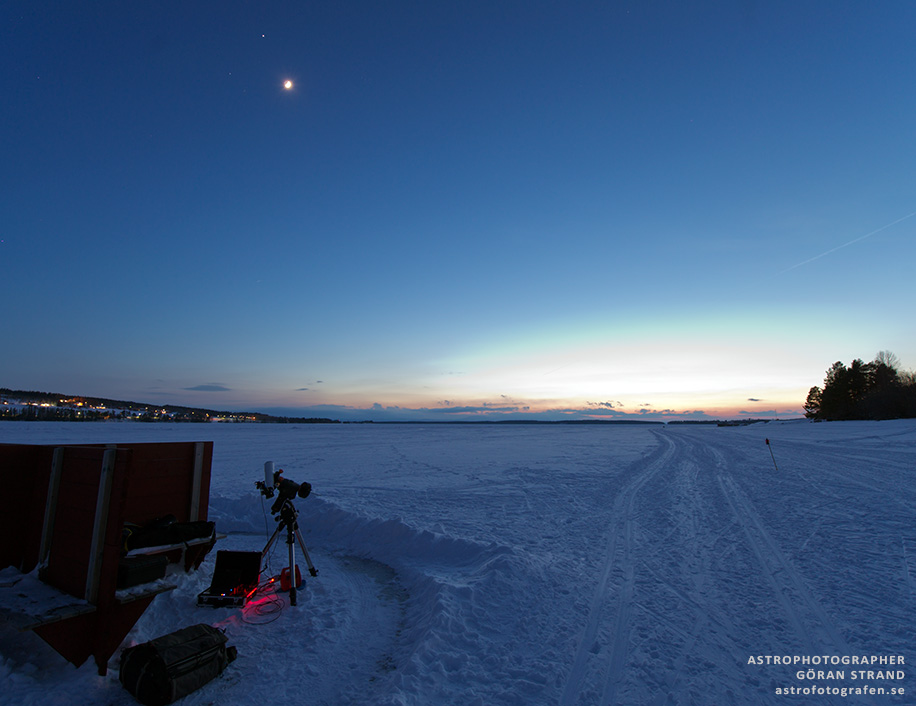
Just after finishing setting up my mount and telescope I looked up I saw a wonderful aurora corona. If you haven't seen a aurora corona before it is best described as if you we're standing under a shower. They come down from the sky right at you and it's one of the most fantastic views you can see. I ran to my camera bag and picked up my Nikon D3s and mounted my Sigma 8mm/f3.5 circular fish eye lens on the body. Grabbed my tripod and attached my camera and took this picture. It's a 6 second exposure at f/4.0 and ISO 1600. Since I pointed my camera straight up, the image shows the entire sky.
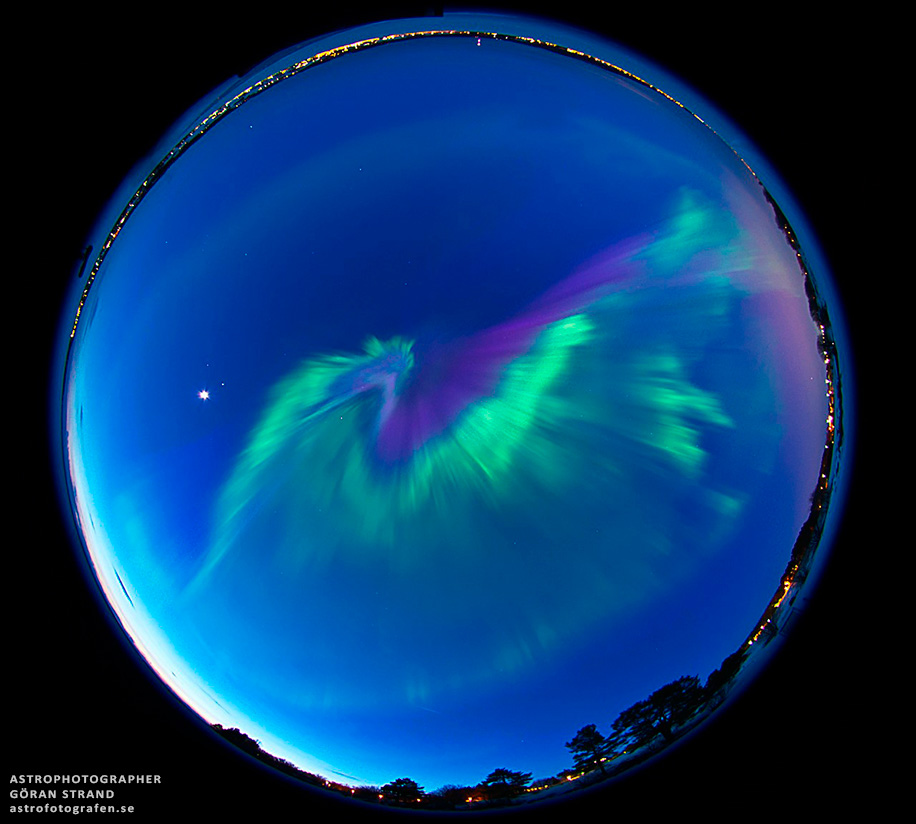
After a few minutes the aurora settle a bit and I realized that this wasn't the night to shoot the comet. I packed my mount and telescope and rigged my Nikon D3s and Sigma 8mm lens to do a full sky time lapse of what would be one of the greatest auroras I ever seen. I set the camera to take 4 second exposures every 6th second and let it run for a little more than 4 hours giving me a total of 2,461 shots for a total of 30Gb data.
Here's a shot I took with my Nikon D800E camera and my Nikon 14-24/f2,8 lens showing me standing under some strong aurora. To the left of me you can see my Nikon D3s pointed straight up running the time lapse.
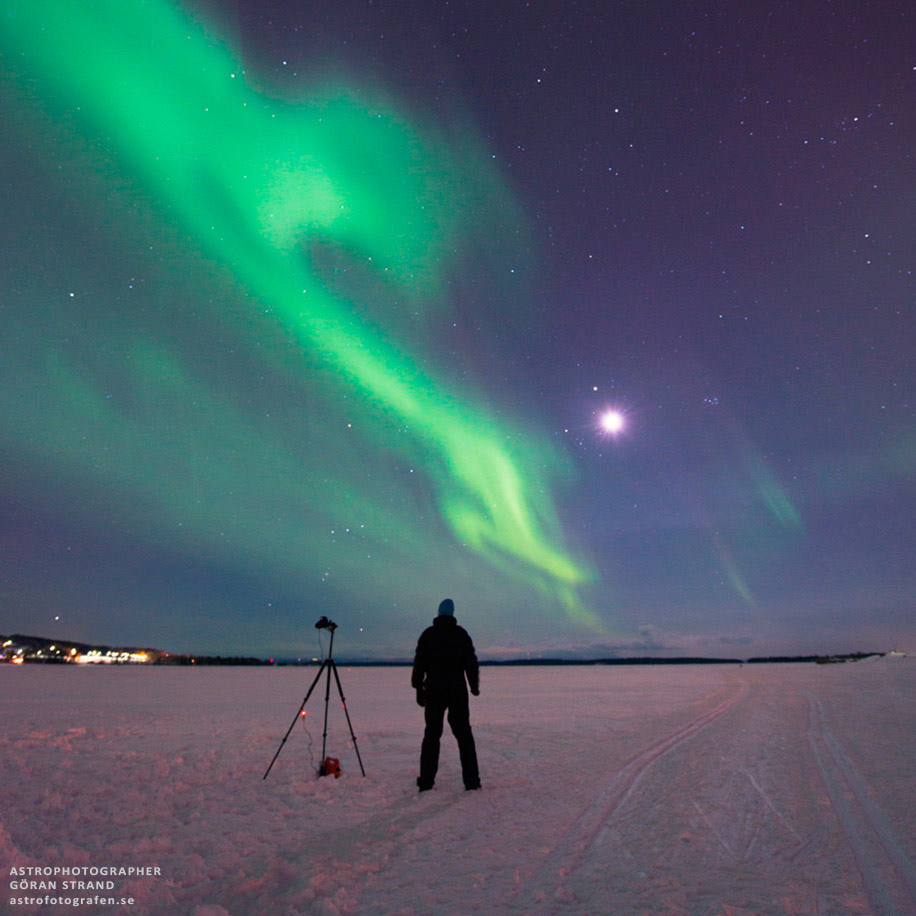
When I came home I started to editing the images for a time lapse video. As I begun editing the movie I realized that I've done some solar photography through my solar telescope a few days earlier. I used that imagery to show from what sunspot the aurora originated and to give the viewers a perspective on how big the Sun is compared to Earth. Here's the shot of the Sun that I took on March 14.
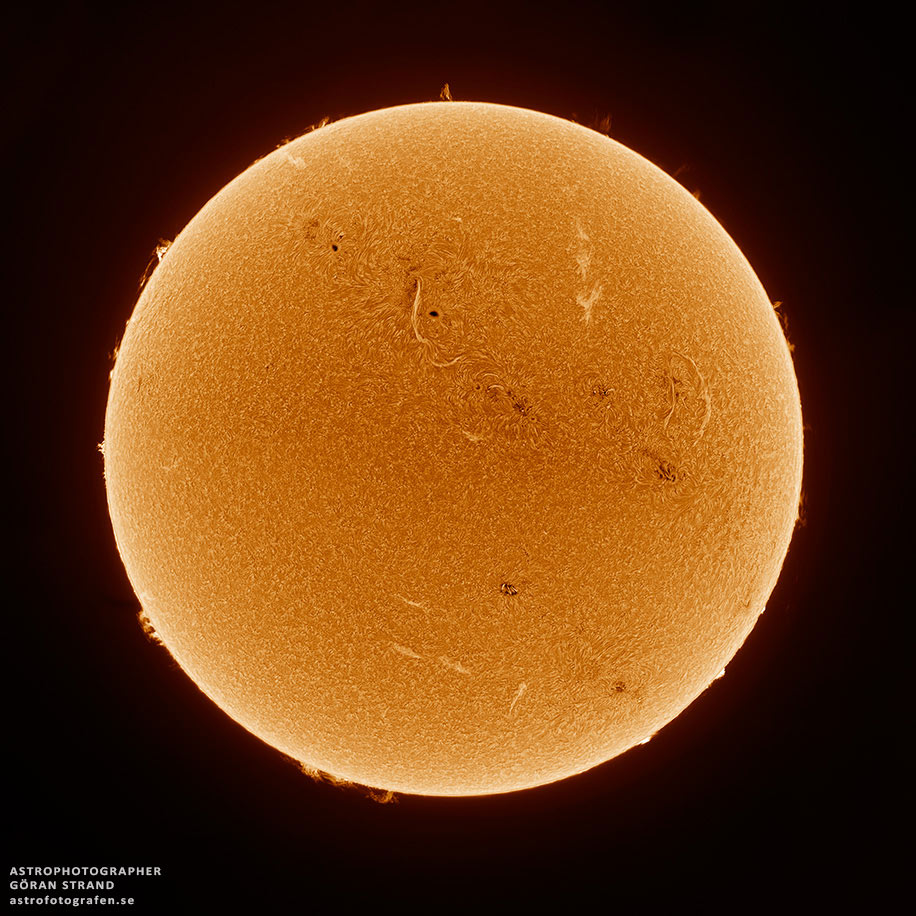
Here you can see the final movie that was published a few days later:
During the next two weeks I received lots of emails and requests about my movie, and one mail in particular gave me an idea. It was one of the biggest planetariums in the world that wanted to purchase the movie to be able to show it in their dome. That night when I went to sleep I thought a lot about how great it would be to visualize this in a way that it felt like you were there on March 17. The very next day I did some search on the Internet and found an solution that allowed me to project my time lapse movie in an artificial world. The software I found was Krpano from Krpano GmbH. After several days of image processing and website programming, my Aurora Virtual Reality Experience was ready:
A few days after publishing this new experience, I got an email from David Wyand, Head of Torque 3D Development at GarageGame. The we're adding Oculus Rift support to their open source game engine, and he wanted to use my footage to make a demo for the Oculus Rift virtual reality headset. A couple of weeks later they were finished and here you can see the result.
I've never gotten the chance to see my aurora with through Oculus Rift, but I would sure like to. If you're a owner of Oculus Rift, please let me know how it looks and feels ![]()
If you have an interesting idea for a guest post, you can contact me here. Göran's photos can be purchased here.
Posted by NikonRumors.com
This RSS feed is copyrighted and cannot be republished in any way without permission.
Follow [NR] on Facebook and Twitter.

Related posts:
Macaframa: Clary Wheelie Sequence

Photo by Mike Sanders
Man, I wish Maca would put out another video already! Seeing shots like this on their Tumblr makes me miss riding a track bike in SF.
Monday
Simple SimonI'm sure Alan came into the office like this a couple of days (and me too...)

You Can Make Bacon At Home. And It’s Delicious.
In about a week you could be eating the best bacon of your entire life. You could be holding in your hand a glistening mahogany slab of perfectly crisped pink, tender, juicy meat streaked through with succulent fat. You could be proclaiming to the world: “Behold what I have made! It is bacon and it is sublime!”
Instead of some lame fruitcake, you could give people what they really want for the holidays: gourmet, handcrafted bacon, straight from your own kitchen. And here’s the secret I can now confidently reveal: making your own bacon at home isn’t just possible – it’s simple.
So, join me, if you will, in an exploration of how to make the best bacon of your life. There will be a few detours and footnotes to talk about some food sciencey-stuff, but if you want to get right to the meat (hah!) of the matter scroll down for the printable recipe.
Ready? Ok! Let’s make bacon!
What Is Bacon?
You know what bacon is, right? Or do you? In the United States, bacon is, by USDA definition, the cured belly of a pig. You rub a section of meat from the belly primal of a pig with a cure – salt, sugar, usually pink salt (more on that later) and seasonings of choice. After curing, bacon is smoked.
But all around the world people cure pork, and they don’t all stampede towards the fatty belly for a sweet-smokey meat kick. This post will teach you how to make American-style slab bacon from the belly of the pig.
Slab bacon is a delicious place to start, but check out this chart which shows some common bacons and bacon-like cured meats. Notice that pretty much every part of the pig can be made into something in the bacon family. Bacon doesn’t end with the belly!
What Do You Need To Make Bacon At Home?
Making bacon at home isn’t hard, it doesn’t require magical meat knowledge or a lot of fancy equipment. But it does require about a week’s time, a pork belly, one weird ingredient called Pink Salt, and a way to smoke your bacon. So while this project is totally, completely worth it, it helps to plan ahead.
1. Pork Belly
Getting a pork belly is not as straightforward or as cheap as you might think. I bought naturally raised happy-hippie pork belly through the wholesale vendor I’ve been working with since my catering days and it cost me $4.70 a pound. I bought three whole bellies, each between 10 and 12 pounds. That is a lot of bacon but I’m not a girl who backs down from a challenge.
If you buy your pork as a whole or half-animal directly from a farmer, ask the butcher to leave the belly whole. For the love of bacon, do not let them grind it!
Any good independent butcher will be able to order you pork belly (if they can’t they aren’t a good independent butcher) but depending on local demand may not have slabs of proto-bacon in stock. Asian and Latin-American markets tend to be a better source of pork belly that your typical suburban supermarket.
Previously frozen pork belly can be used to make bacon but your end product won’t be quite as moist.
2. Pink Salt
See full explanation below in the footnote. The TL;DR version is: pink salt is a special curing salt that ensures you don’t make Botulism Bacon. Order it online. This is what I use.
3. Smoker and Woodchips
For the smoker, I used a small “Little Chief” Electric Smoker given to me years ago by my sister and brother-in-law. (Guess what favorite cured meat they are getting for Christmas?) The smoker I have is a bitty thing - I have an older version of this model - and if you’re willing to invest a hundred bucks in a smoker I would recommend something more substantial. We are so overwhelmed by the awesomeness of homemade bacon that we are looking at upgrading to this smoker for Christmas.
But if this is your first time making bacon, you probably don’t want to invest in dedicated smoking equipment. You can rig a charcoal, Weber-style grill as a smoker. (See excellent instructions here, but note that for our bacon we want to keep the temperature at around 200-225 degrees.)
You can also build your own smoker out of, among other things, flower pots (clean ones, without flowers in them). Full instructions on building a flower pot smoker here. I’ve never done this, but it looks fairly legit.
You can also stovetop smoke your bacon. Check out this process for making a stovetop smoker at home with stuff you probably already have on hand. But – fair warning – indoor smoking will leave your entire house smelling like a campfire. For days. And unless you have some serious industrial ventilation in your kitchen, you might want to temporally silence any smoke alarms in the house. (Put those batteries back in, though!) Stovetop smoking works best to impart an initial smokey flavor and color, and you can finish cooking your bacon in a 225-degree oven. It’s not exactly the same, but it’ll do in a pinch.
For wood, I used bags of hardwood apple chips I picked up at the grocery store, like these. They aren’t too expensive. A $5 bag smoked two complete pork bellies, or about 20 pounds of bacon. You can use other types of smoking chips or chunks - alder, mesquite, etc. – depending on what your smoker set-up is, just make sure you are using fully dried hardwood chips designed for smoking. If you use any old woodchips from the muni tree grinding service you’ll get nastiness.
Making Bacon At Home: Step by Step
I’ve broken this down into lots of steps with lots of pictures, but don’t let that intimidate you. Each step is super easy.

1. Get To Know Your Pork Belly
Here’s a pork belly, fat-side up.

Here’s a pork belly, skin-side down. You can see where the full belly was cut off the ribs (those little fingery looking lines in the belly).
Here’s a pork belly in cross-section. Ah, now the bacony potential becomes apparent!
2. Trim Belly As Necessary
If you belly came with skin-on, carefully trim away the skin, leaving as much fat as possible. Mine came skin-off so I didn’t have to do this step.
Trim off any particularly thick membranes on the underside of the belly where the ribs connected. Smoke typically doesn’t permeate thick membranes like that, and they don’t break down with cooking, so they are like eating a rubber band. Below-right on this photo shows the belly before trimming; top-left shows it after trimming.
3. Cut Belly into Manageable Size Pieces
You could cure and smoke a whole belly, but you’ll need more specialty equipment. Cutting this 12-pound belly in thirds gave me pieces just the right size to fit into gallon-size ziptop bags. That’ll make life easier at cure time.
It’s important that your cure be properly calibrated to the amount of meat you are curing. The recipe in this post is designed for 4 pounds of pork belly (give or take a few ounces). If you cure a different amount, you must adjust the cure amounts accordingly.
4. Prepare Cure
Combine all cure ingredients in a bowl and mix well. Measure carefully and be particularly precise about the Pink Salt.
This is how the Pink Salt comes packaged.

5. Rub That Cure On Yer Meat
Really get in there and work the salt and sugar and spices into the belly. Give it a little massage and talk sweetly to it. This belly is going to be your bacon, after all.
6. Bag, Wait, Flip, Wait
Put your cure-rubbed pork belly in a large, heavy-duty ziptop bag. If any cure fell off the belly, throw it in the bag, too. Squeeze as much air out of the bag as you can without doing something gross with a straw, and seal it well.
Now, put your curing belly in the refrigerator. Soon, the salt and sugar will mingle with the juice from the pork and form a thick kind-of brine around the belly. Every day, more or less, turn the belly over so that all sides have equal time with the cure. This is why the ziptop bag is so great: you just flip the whole thing over without opening it. Give your pork belly seven to ten days to cure. After a week it should feel quite firm, but still pliable if you bend it. If it still feels soft, you can cure it for another day and check again.
7. Rinse Your Cured Pork Belly
After the pork belly is sufficiently cured, remove it from the bag and rinse it well. Some peppercorns may be stuck into the fat a bit and that’s ok, but do try to get most of the cure off the meat. This photo is from another batch of bacon I made with fresh garlic. Ignore the garlic hunks.
8. Check Pork Belly Flavor
When you are still getting the hang of how cured you want your bacon, it’s a good idea to do a taste-test before smoking. Although the bacon is cured at this point, it’s still raw, and, for a number of food safety reasons, I recommend cooking it before tasting. Just cut off a small sliver of the bacon and cook it gently.
If your reaction to the bacon is, “Wow, this tastes a lot like really good bacon!” then – excellent! – proceed to the next step. If your reaction is “Did I just eat a salt-lick?!” then your bacon may be slightly overcured. Remember you want something very flavorful, but if it’s excessively salty, you can fix it! Just soak your belly in cold water for a few hours and do the taste test again. The excess salt should be tamed.
9. Dry The Belly To Form A Pellicle
Here’s a fun fact about me: one of my favorite words is pellicle. A pellicle is the dry, tacky skin on meat or fish necessary for good smoking. Basically, moist meat doesn’t take smoke color or flavor very well, so before we smoke our bacon we have to dry it out.
The easiest way to do this is to put the bacon on a cooling rack over a sheet pan and pop in the refrigerator, uncovered, overnight. But I was impatient so I invoked a fan. It took about an hour to fully dry the meat with a fan assist like this, but don’t rush it. You want that nice, tacky-dry surface. I dried one batch on a cooling rack, and another right on the smoking rack that came with my Little Chief Smoker.

10. Smoke Your Bacon!
Okay, here’s where the magic happens. Prepare your smoker, grill, or whatever you are using to smoke your bacon. Get some nice hardwood smoke happening and then load your bacon. Keep the temperature in your smoker between 200 and 225 degrees as much as possible. Periodically check the chips and top up if necessary, but also pay attention to how much smoke color and aroma your bacon is developing. You may want to ease back on the smoke towards the end. I did.
11. Check – Is Your Bacon Done?
Bacon is done when the internal temperature is 150-degrees F (this bacon slab got there just after I snapped the pic below) and the bacon looks like lacquered love. In a good, efficient smoker this should take about two hours. In my smoker it took more like four hours.
Sidenote: Why 150-degrees?
At 150-degrees internal temperature, the bacon is glistening and lovely and the meat is fully cooked. However, very little of the fat has melted – most is still intact, so when you slice the bacon for later pan-frying, it looks like this:
I overshot on one of my bacon slabs and didn’t end up pulling it out of the smoker until it had an internal temperature of 180-degrees. That’s a big difference! The result was that the fat layers were starting to liquify and the meat was taking on a slow-braised quality, like this:
Now I don’t want you to get the wrong idea – this bottom example bacon was still unbelievably delicious. Even bad bacon, as they say, is pretty good, and this was still worlds better than anything store bought. However, this shows why 150-degrees is our bacon temperature sweet spot.
12. Eat Your Bacon
At this point, your bacon is fully cooked and you can, if you desire, start eating it. However, if you are a typical American bacon eater, you will probably want to pan-fry or oven roast a few slices to crispy, chewy perfection.
Slice as you desire – as thin as I could confidently slice made hunking thick-cut bacon slices of magnitude. Cook this bacon gently – give it time over medium or medium-low heat and it will reward you.
No joke: best bacon I’ve ever eaten. Seriously, what are you waiting for?
Printable Recipe For The Best Bacon Ever
- 4 pound pork belly
- 1 cup brown sugar
- ½ cup kosher salt
- ¾ tsp pink salt
- 1 tbsp cracked black peppercorn
- 4 pound pork belly
- 1 cup brown sugar
- ½ cup kosher salt
- ¾ tsp pink salt
- 1 tbsp cracked black peppercorn
- 2 fresh bay leaves, sliced
- 1 tablespoon minced fresh thyme
- 4 pound pork belly
- 1 cup brown sugar
- ½ cup kosher salt
- ¾ tsp pink salt
- 1 tbsp cracked black peppercorn
- 1 tbsp Garam Masala
- Prepare pork belly by removing any skin or tough connective tissue and, if necessary, cut belly into 4-pound slabs.
- Combine cure ingredients and rub cure on belly, working cure into meat. Transfer belly and any extra cure into to a gallon-size ziptop bag.
- Refrigerate belly for seven to ten days, flipping belly once a day, until meat is fully cured and firm but still pliable.
- Rinse cure off belly, and dry well. Allow meat to form a pellicle by drying overnight in the refrigerator uncovered or setting meat on a rack in front of a fan.
- Prepare smoker. Smoke belly over hardwood smoking chips at 200-225 degrees for about 2 hours, until internal temperature of pork reaches 150-degrees F.
- Wrap bacon well and refrigerate for several weeks, or freeze for up to three months.
- To serve, slice thinly and pan-fry over medium or oven-roast slowly.
Footnote: Pink Salt, Prague Powder, Nitrites, Etc.
Pink Salt, also called Prague Powder, InstaCure or DQ Salt is a curing salt. You don’t use it for flavoring or seasoning – you use it to preserve meat and a little goes a long way.
It’s called Pink Salt because it is dyed pink so no one mistakes it for table salt. It is not the same as Himalayan pink salt! I saw a website telling people they needed to use Himalayan Pink Salt to cure their meats and I almost choked on my slab of pate. Not the same thing! So, to emphasize: Himalayan salt – or any other fancy boutique finishing salt of any color at all – is not what you need here.
There are two standard formulations of curing salt.
Prague Powder #1 (also called InstaCure #1) contains table salt and 6.25% sodium nitrite and is used for sausages, cured meats, pates, deli meats, etc that are cooked – smoked, baked, roasted, canned, whatever. Basically any cured meat that isn’t long-aged like a dry-cured salami. This is what we use when we make bacon. You can get it here.
Prague Powder #2 (also called InstaCure #2) is used for long aged dry-cured meats like prosciutto and hard salami. It has table salt, sodium nitrite (6.25%) and sodium nitrate (1%). The nitrate acts as a kind of slow-release preservative for very long-cured meats. We don’t use it to make bacon or other short-cured items.
Nitrites? Are You Ni-Trying To Kill Me?!
“Wait!” I hear some of you saying, “Nitrites! Oh my God, evil toxic additives.” Hold on a second – before you slam your laptop lid in disgust, let me break down my position on Pink Salt for you.
Remember our old frienemy Mr. Botulism Toxin? (See: How Not To Die of Botulism) Did you know that botulism was first described “as a ‘sausage poison’ and ‘fatty poison’, because the bacterium that produces the toxin often caused poisoning by growing in improperly handled or prepared meat products.” (Wikipedia, emphasis mine.) Even botulism’s name comes from a cured meat product: botulus is Latin for sausage.
Sodium nitrite in the form of pink salt, when used according to established standards, prevents the growth of C. Botulinum and the development of the botulism toxin in cured meats. That’s why it’s in there. As an added bonus, the nitrite enhances color, flavor, and texture in the cured meat.
Okay, so on one hand we have this established risk of botulism growth in improperly cured meat products. On the other hand we might have the potential risk of nitrites. So we have to ask ourselves, what is the risk from nitrites when used according to established guidelines? I believe the answer is – little to none, but of course this is something you should investigate if it concerns you. For more info, I recommend The “No Nitrites Added” Hoax by Micheal Ruhlman. I am, personally, firmly in the pro-Pink Salt category.
Related Stuff…
(These are affiliate links. Purchases made through these links cost you nothing extra but allow me to bring you more giant step-by-step cured meat tutorials. Full financial disclosure here. Thanks for your support, guys, I love ya more than a homemade BLT in late August.)
America’s Test Kitchen DIY Cookbook. This book is fabulous. If you are the kind of person who reads all the way to the end of a three-thousand word primer on homemade bacon, you should go buy this book right now. It has all kinds of fun DIY Kitchen projects, from bacon to crackers, granola to jam, cheese to pate. And every recipe I’ve made from here (eight at last count) has turned out spectacularly well.
Charcuterie: The Craft of Salting, Smoking, and Curing and Salumi: The Craft of Italian Dry Curing, both by Michael Ruhlman. If you want to go deeper into cured meats, you would be hard pressed to find a more enthusiatic guide than Ruhlman in these two books. Also check out his excellent personal website.
Pink Salt. Remember, you want Prague #1 for bacon and everything that isn’t long-dried. This link goes to the same pink salt I use.
Wood Chips. I like Applewood because they are mild and have a fruity note that complements pork wonderfully. But play around – there are lots of different kinds of smoking wood.
Dedicated Smoker. If you have the room and the funds, there are a lot of options out there. I am leaning to upgrading to this Masterbuilt Electric Smoker because it gets excellent reviews, is electric (easier for me than propane) and hits a good value-conscious price point. I definitely recommend looking for adjustable temperature controls and an auto-shut off timer. Those are two features I really would have liked.
Photos: Beijing's startling air-quality changes within six consecutive days
Simple SimonWe've had several days of double-digit AQI! That meant we had blue skies when we went to the great wall, and all weekend it was lovely! It gave me a beautiful sunset to remember Beijing by.
Check out Taiwan's super-scary ninja riot police
Simple SimonHo-lee shee-it!
This Restaurant Facade Tricks The Eye With Tape
Based in Madrid and Barcelona, this team of interior designers and art directors banded together to form (fos), a multidisciplinary agency that tackles all kinds of projects, including this ephemeral installation they call (fos). Named after their own agency, (fos) means “melted” in Catalan and “light” in Greek, which happens to perfectly describe the new façade of this restaurant in Madrid.
By using the color yellow to trick the eye, the restaurant’s façade now gives off a visual illusion of a projected beam of light from the light fixture hanging above. The team got busy with gobs of yellow tape, pineapples, painted pieces of art, lawn furniture, and accessories to create a visual spectacle that messes with your perspective.
When standing directly in front of the building, it looks as if an exaggerated single beam of light is shining down on the building and street. The yellow tape covers both the walls and street surfaces, following along with the shape of the beam. The results create a “visual game of perspective and colored volumes” that are sure to draw attention from anyone passing by.
Without one-child policy, China's extra population would surpass US' entire population
Photo
Simple SimonThis was applicable for my time in Kazakhstan especially, and somewhat in China. There are a lot of ropey bars that I've not been to yet here!






